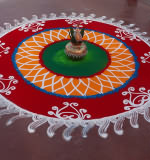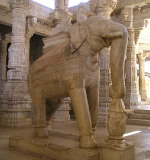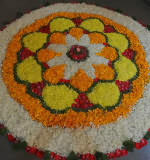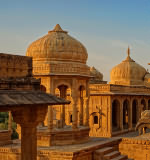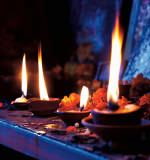| Download and install the indispensable font(s) to view Sanskrit in its full glory Read Transliterating (2) (English) to fully understand the transliteration system |
Tantrāloka (Tantraloka): Chapter 15 - stanzas 160 to 307 - Non-dual Shaivism of Kashmir
Dīkṣā sāmayī
Introduction
 This is the second set of stanzas (from the stanza 160 to the stanza 307) of the fifteenth chapter (called Dīkṣā sāmayī).
This is the second set of stanzas (from the stanza 160 to the stanza 307) of the fifteenth chapter (called Dīkṣā sāmayī).
This work was written by the great Master Abhinavagupta and is a compendium of Tantra in all its facets. Tantrāloka is the most important and voluminous work of the greatest Trika Master. Abhinavagupta was also the teacher of eminent Kṣemarāja and lived about 975-1025 AD in Kashmir.
This treatise whose name is Tantrāloka is a complete encyclopedia of Tantra. Since it is a very advanced text in Trika Shaivism, there is no surprise if a neophyte finds it difficult to understand. To start to understand it, the level of the reader must be the one of a real disciple in Trika Shaivism. If this requirement is not met, then there will be a lot of confusion and constant disappointment. Because in spite of my great efforts to explain the things so easily as possible, to study this treatise requires some spiritual caliber. In this system, sometimes it is not possible even to write about certain topics due to the extreme limitation of the words. Because in the end, all this knowledge has to do with 'states', and it is extremely difficult to write about 'states' in a precise way. Abhinavagupta has done his best to accomplish this formidable task of writing about what is superior and intangible. Anyway, despite his incredible skills to carry out this, he is not revealing everything. It is not because he is all the time hiding things from the reader, but because he is sometimes hiding and on other occasions he just cannot write about some extremely subtle topics because of the limitation of the words.
Goal of life is Liberation. Man has searched for freedom always in human history, but according to Trika Shaivism that is not real Liberation. Real Liberation does not mean that your body should be free from some prison and things like that. Real Liberation amounts to attaining His Svātantrya or Absolute Freedom. When the Great Lord's Svātantrya is achieved, then you see unity in all the things, i.e. you stop seeing duality as before. All is forever identified with Svātantrya, with Him, and that is the end of the story called 'you in bondage'. From this point on nothing will get in your way, because if something apparently gets in your way, that is Svātantrya again. This constant awareness of unity in all is real Freedom. There is no other attainment greater than this!
Keeping the above in mind, now read Tantrāloka and experience Supreme Delight, dear Śiva.
Important: All that is in brackets and italicized within the translation has been added by me in order to complete the sense of a particular phrase or sentence. In turn, all that is between double hyphen (--...--) constitutes clarifying further information also added by me.
Stanzas 160 to 176
अर्घपात्रमपादानं तस्मादादीयते यतः।
यच्च तत्स्थं जलाद्येतत्करणं शोधनेऽर्चने॥१६०॥
अर्घपात्राम्बुविप्रुड्भिः स्पृष्टं सर्वं हि शुध्यति।
शिवार्ककरसंस्पर्शात्कान्या शुद्धिर्भविष्यति॥१६१॥
ऊचे श्रीपूर्वशास्त्रे तदर्घपात्रविधौ विभुः।
न चासंशोधितं वस्तु किञ्चिदप्युपकल्पयेत्॥१६२॥
तेन शुद्धं तु सर्वं यदशुद्धमपि तच्छुचि।
अशुद्धता च विज्ञेया पशुतच्छासनाशयात्॥१६३॥
स्वतादवस्थ्यात्पूर्वस्मादथवाप्युपकल्पितात्।
तेन यद्यदिहासन्नं संविदश्चिदनुग्रहात्॥१६४॥
कियतोऽपि तदत्यन्तं योग्यं यागेऽत्र जीववत्।
अनेन नययोगेन यदासत्तिविदूरते॥१६५॥
संविदेति तदा तत्र योग्यायोग्यत्वमादिशेत्।
वीराणामत एवेह मिथःस्वप्रतिमामृतम्॥१६६॥
तत्तद्यागविधाविष्टं गुरुभिर्भावितात्मभिः।
उन्मज्जयति निर्मग्नां संविदं यत्तु सुष्ठु तत्॥१६७॥
अर्चायै योग्यमानन्दो यस्मादुन्मग्नता चितः।
तेनाचिद्रूपदेहादिप्राधान्यविनिमज्जकम्॥१६८॥
आनन्दजननं पूजायोग्यं हृदयहारि यत्।
अतः कुलक्रमोत्तीर्णत्रिकसारमतादिषु॥१६९॥
मद्यकादम्बरीशीधुद्रव्यादेर्महिमा परम्।
लोकस्थितिं रचयितुं मद्यादेः पशुशासने॥१७०॥
प्रोक्ता ह्यशुद्धिस्तत्रैव तस्य क्वापि विशुद्धता।
पञ्चगव्ये पवित्रत्वं सोमचर्णनपात्रयोः॥१७१॥
विधिश्चावभृथस्नानं हस्ते कृष्णविषाणिता।
न पत्न्या च विना यागः सर्वदैवततुल्यता॥१७२॥
सुराहुतिर्ब्रह्मसत्रे वपान्त्रहृदयाहुतिः।
पाशवेष्वपि शास्त्रेषु तददर्शि महेशिना॥१७३॥
घोरान्ध्यहैमननिशामध्यगाचिरदीप्तिवत्।
भक्ष्यो हंसो न भक्ष्योऽसाविति विप्रतिपत्तिषु॥१७४॥
स्मार्तीषु विजयत्येको यः शिवाभेदशुद्धिकः।
अज्ञत्ववेदादर्शित्वरागद्वेषादयो ह्यमी॥१७५॥
मुनीनां वचसि स्वस्मिन्प्रामाण्योन्मूलनक्षमाः।
वेदेऽपि यदभक्ष्यं तद्भक्ष्यमित्युपदिश्यते॥१७६॥
Arghapātramapādānaṁ tasmādādīyate yataḥ|
Yacca tatsthaṁ jalādyetatkaraṇaṁ śodhane'rcane||160||
Arghapātrāmbuvipruḍbhiḥ spṛṣṭaṁ sarvaṁ hi śudhyati|
Śivārkakarasaṁsparśātkānyā śuddhirbhaviṣyati||161||
Ūce śrīpūrvaśāstre tadarghapātravidhau vibhuḥ|
Na cāsaṁśodhitaṁ vastu kiñcidapyupakalpayet||162||
Tena śuddhaṁ tu sarvaṁ yadaśuddhamapi tacchuci|
Aśuddhatā ca vijñeyā paśutacchāsanāśayāt||163||
Svatādavasthyātpūrvasmādathavāpyupakalpitāt|
Tena yadyadihāsannaṁ saṁvidaścidanugrahāt||164||
Kiyato'pi tadatyantaṁ yogyaṁ yāge'tra jīvavat|
Anena nayayogena yadāsattividūrate||165||
Saṁvideti tadā tatra yogyāyogyatvamādiśet|
Vīrāṇāmata eveha mithaḥsvapratimāmṛtam||166||
Tattadyāgavidhāviṣṭaṁ gurubhirbhāvitātmabhiḥ|
Unmajjayati nirmagnāṁ saṁvidaṁ yattu suṣṭhu tat||167||
Arcāyai yogyamānando yasmādunmagnatā citaḥ|
Tenācidrūpadehādiprādhānyavinimajjakam||168||
Ānandajananaṁ pūjāyogyaṁ hṛdayahāri yat|
Ataḥ kulakramottīrṇatrikasāramatādiṣu||169||
Madyakādambarīśīdhudravyādermahimā param|
Lokasthitiṁ racayituṁ madyādeḥ paśuśāsane||170||
Proktā hyaśuddhistatraiva tasya kvāpi viśuddhatā|
Pañcagavye pavitratvaṁ somacarṇanapātrayoḥ||171||
Vidhiścāvabhṛthasnānaṁ haste kṛṣṇaviṣāṇitā|
Na patnyā ca vinā yāgaḥ sarvadaivatatulyatā||172||
Surāhutirbrahmasatre vapāntrahṛdayāhutiḥ|
Pāśaveṣvapi śāstreṣu tadadarśi maheśinā||173||
Ghorāndhyahaimananiśāmadhyagāciradīptivat|
Bhakṣyo haṁso na bhakṣyo'sāviti vipratipattiṣu||174||
Smārtīṣu vijayatyeko yaḥ śivābhedaśuddhikaḥ|
Ajñatvavedādarśitvarāgadveṣādayo hyamī||175||
Munīnāṁ vacasi svasminprāmāṇyonmūlanakṣamāḥ|
Vede'pi yadabhakṣyaṁ tadbhakṣyamityupadiśyate||176||
Ablative case (apādānam) (is) the vessel (arghapātram) because (yatas) (the water, etc.) is extracted/taken out (ādīyate) from it --i.e. from the vessel-- (tasmāt). And (ca) the water, etc. (jala-ādi) that (yad) is in it --in the vessel-- (tad-stham) (is) the instrument (karaṇam) regarding purification and worship (śodhane arcane) --so water would be the instrumental case--.
All (sarvam) that is touched (spṛṣṭam) by the drops of the water (contained in) the vessel (arghapātra-ambu-vipruḍbhiḥ) becomes pure (hi śudhyati). What (kā) purification (śuddhiḥ) will there be (bhaviṣyati) other (anyā) than the contact with the rays of the Sun of Śiva (śiva-arka-kara-saṁsparśāt)?
The All-pervading One (vibhuḥ) spoke (ūce) in venerable Mālinīvijayottaratantra (śrī-pūrva-śāstre) about the use of that vessel --or "about the procedure with that vessel"-- (tad-arghapātra-vidhau): 'And (na) one should not assume (na... upakalpayet) that some (kiñcid api) thing (vastu) is not completely purified (asaṁśodhitam) (by the vessel). By it --i.e. by the vessel-- (tena), everything (sarvam) (becomes) pure (śuddham) indeed (tu), (and) what (yad... tad) is even impure (aśuddham api) (becomes) pure (śuci... iti)'.
And (ca) what is known as (vijñeyā) impurity (aśuddhatā) (comes) from the mode of thinking of paśu-s --viz. limited beings in bondage-- and their doctrines (paśu-tad-śāsana-āśayāt).
Since there is a remaining in its --his, her and their are included-- same state (sva-tādavasthyāt) (either) before (pūrvasmāt) or even (athavā api) (afterward) when it --or he, she, they-- has been prepared (upakalpitāt) --Sanskrit is very confusing--.
For that reason (tena), whatever (yad yad) (is) here (iha) near (āsannam) Consciousness (saṁvidaḥ) through the Favor of Consciousness (cit-anugrahāt), even (api) a little bit (kiyatas), that (tad) is totally fit (to become an offering) (atyantam yogyam) here (atra) in the sacrifice (yāge), like a living being is (too) (jīva-vat) --"jīvavat" also means "possessing life", i.e. "living", in neuter gender; so another possible translation would be "that is totally fit (to become an offering) and is (totally) living here in the sacrifice"; hopefully it is clear--.
By means of this maxim/doctrine (anena naya-yogena), when (yadā) Consciousness (saṁvit) is near or far (āsatti-vidūrate... eti), then (tadā) (that) indicates (ādiśet) fitness or lack of it (yogya-ayogyatvam) for it --i.e. to become an offering-- (tatra).
On this account (atas eva), here (iha), the Nectar of the heroes (produced by) their figures together --it refers to the Nectar called kuṇḍagola generated by the sexual union between the officiant/sacrificer/worshiper and his consort-- (vīrāṇām... mithas-sva-pratima-amṛtam) has been delivered/assigned to (each) kind of the various sacrifices (tad-tad-yāga-vidha-āviṣṭam) by the Guru-s whose souls have been purified by meditation (gurubhiḥ bhāvita-ātmabhiḥ).
That (tad) which (yad tu) causes the immersed Consciousness to exceedingly emerge (unmajjayati nirmagnām saṁvidam... suṣṭhu) (is) fit (yogyam) for worship (arcāyai) because (yasmāt) Bliss (ānandaḥ) (is) the emergence (unmagnatā) of Consciousness (citaḥ).
On that account (tena), that which (yad) ravishes the heart (hṛdaya-hāri), brings about the immersion of the predominance of body, etc., which is not Consciousness (acit-rūpa-deha-ādi-prādhānya-vinimajjakam), (and) generates Bliss (ānanda-jananam), is fit for worship (pūjā-yogyam).
For this reason (atas), the greatness (mahimā) of substances such as wine, kādambarī --a liquor distilled from the flowers of the Kadamba tree--, śīdhu --a liquor distilled from molasses--, etc. (madya-kādambarī-śīdhu-dravya-ādeḥ) (is) supreme (param) in Trikasāra, Mata, etc. which are beyond/above Kula-krama --this term might mean "Kula and Krama" (these two schools of Trika Shaivism) or else "the processes of the Kula school"-- (kula-krama-uttīrṇa-trikasāra-mata-ādiṣu).
Impurity (aśuddhiḥ) of wine, etc. (madya-ādeḥ) is mentioned (proktā) in the doctrine of the paśu-s --i.e. of the limited beings in bondage, in this case, it refers to the Veda-s-- (paśu-śāsane) in order to produce (racayitum) the establishment of good order in the world (loka-sthitim). (Anyway,) right there --viz. in the doctrine of the paśu-s-- (tatra eva), the purity (viśuddhatā) of that (tasya) (is mentioned) somewhere (kvāpi).
The state of being a means of purification (pavitratvam) with reference to the five products of the cow --milk, coagulated milk, butter, and the liquid and solid excreta-- (pañca-gavya) and (ca) the procedure (vidhiḥ) with reference to the pressing out/extracting --according to Jayaratha "carṇana" means "abhiṣava" or "pressing out/extracting of the Soma juice"; but others read "carvaṇa" or "chewing/tasting"-- of the Soma juice and the bowl where it is collected (soma-carṇana-pātrayoḥ), the ablution after a sacrificial ceremony (avabhṛtha-snānam), the horn of a black antelope (kṛṣṇa-viṣāṇitā) in the hand (of the officiant/sacrificer/worshiper) (haste), and (ca) without the wife (of the officiant/sacrificer/worshiper) (patnyā... vinā) there is no sacrifice (na... yāgaḥ), the equality of all the deities (sarva-daivata-tulyatā), the libation of surā --of a kind of beer, some say it is "rice beer"-- (surā-āhutiḥ) in Brahmasatra --it would have been better to write "Brahmasattra"; here Brahma means "the Vedic scriptures" and "sattra" means "session", it is a special sacrifice to venerate the Veda-s; it might also mean the sacrifice of a brāhmaṇa or priest, i.e. a human sacrifice-- (brahma-satre), (and) the offering of the marrow, entrails and heart (of the victim in the sacrifice) as an oblation (vapā-antra-hṛdaya-āhutiḥ) --Abhinavagupta is mentioning here situations during the Vedic sacrifices where the normal Vedic rules are ignored--.
That (tad) was shown --this is an Aorist in Passive voice, 3P singular, of the root "dṛś" (to see, perceive)-- (adarśi) by the Great Lord (mahā-īśinā) even (api) in the scriptures of the paśu-s --in the Veda-s-- (pāśaveṣu... śāstreṣu) like a brief light/splendor in the middle of the winter's night of terrible darkness (ghora-āndhya-haimana-niśā-madhyaga-acira-dīpti-vat).
Only one who (ekaḥ yaḥ) has been purified by the Śiva's non-duality (śiva-abheda-śuddhikaḥ) is victorious (vijayati) over all those scriptures belonging to the Smṛti --Smṛti is generally the group of traditional Vedic scriptures such as Vedāṅga-s, Dharmaśāstra-s, Itihāsa and Purāṇa-s-- (smārtīṣu) in which there is mutual discrepacies (vipratipattiṣu), e.g. "That (asau) goose (haṁsaḥ) (is) eatable (bhakṣyaḥ) (and that goose) is not eatable (na bhakṣyaḥ... iti)".
Those (things) (amī) that are able to uproot the authoritiveness/credibility (prāmāṇya-unmūlana-kṣamāḥ) with regard to the very speech (vacasi svasmin) of the (Vedic) sages (munīnām) (are things such as their) ignorance (about the Veda-s themselves), (the fact that they) have not seen the Veda-s, (their) attachment, aversion, etc. (ajñatva-veda-adarśitva-rāga-dveṣa-ādayaḥ hi).
Even (api) in the Veda (itself) (vede) it is taught (upadiśyate) that (iti) what (yad) is not eatable (abhakṣyam) is eatable (tad bhakṣyam) --which is a total contradiction--||160-176||
Stanzas 177 to 180
न विधिप्रतिषेधाख्यधर्मयोरेकमास्पदम्।
अथ तत्र न तद्भक्ष्यं तदा तेन तथा ततः॥१७७॥
एवं विषयभेदान्नो शिवोक्तेर्बाधिका श्रुतिः।
क्वचिद्विषयतुल्यत्वाद्बाध्यबाधकता यदि॥१७८॥
तद्बाध्या श्रुतिरेवेति प्रागेवैतन्निरूपितम्।
प्रकृतं ब्रूमहे कृत्वा न्यासं देहार्घपात्रयोः॥१७९॥
सामान्यमर्घपात्राम्भोविप्रुड्भिः प्रोक्ष्य चाखिलम्।
यागोपकरणं पश्चाद्बाह्ययागं समाचरेत्॥१८०॥
Na vidhipratiṣedhākhyadharmayorekamāspadam|
Atha tatra na tadbhakṣyaṁ tadā tena tathā tataḥ||177||
Evaṁ viṣayabhedānno śivokterbādhikā śrutiḥ|
Kvacidviṣayatulyatvādbādhyabādhakatā yadi||178||
Tadbādhyā śrutireveti prāgevaitannirūpitam|
Prakṛtaṁ brūmahe kṛtvā nyāsaṁ dehārghapātrayoḥ||179||
Sāmānyamarghapātrāmbhovipruḍbhiḥ prokṣya cākhilam|
Yāgopakaraṇaṁ paścādbāhyayāgaṁ samācaret||180||
In the case of the duties known as rule and prohibition (vidhi-pratiṣedha-ākhya-dharmayoḥ), one (ekam) place/abode (āspadam) does not exist (na).
Now (atha), there (tatra), that (tad) is not eatable (na... bhakṣyam) then (tadā), by him (tena), (but) for that reason (tatas) (it is) so --i.e. it is eatable-- (tathā). Thus (evam), the Śruti --Veda-s in general-- (śrutiḥ) is not annulling (na... bādhikā) Śiva's statement (śivas-ukteḥ) due to the difference in the spheres (of application) (viṣaya-bhedāt).
If (yadi) (there is) a state of invalidating what has been invalidated (bādhya-bādhakatā) because of equality in the spheres (of application) (viṣayatulyatvāt) somewhere (kvacid), then (tad) the Śruti herself (śrutiḥ eva) becomes invalidated (bādhyā). This (etad) has been described (nirūpitam) in this way (iti) before (prāk eva).
(Now) I will expound --lit. we expound-- (brūmahe) the subject under discussion (prakṛtam): After performing (kṛtvā) general (sāmānyam) nyāsa (nyāsam) on body and vessel (deha-arghapātrayoḥ) and (ca) after sprinkling (prokṣya) on all the implements for the sacrifice (akhilam... yāga-upakaraṇam) with the drops of the water of the vessel (arghapātra-ambhas-vipruḍbhiḥ), after (all that) (paścāt), he should perform (samācaret) the external sacrifice (bāhya-yāgam)||177-180||
Stanzas 181 to 193
प्रभामण्डलके खे वा सुलिप्तायां च वा भुवि।
त्रिशूलार्कवृषान्दिक्स्था मातरः क्षेत्रपं यजेत्॥१८१॥
योगिनीश्च पृथङ्मन्त्रैरोंनमोनामयोजितैः।
एकोच्चारेण वा बाह्यपरिवारेतिशब्दिताः॥१८२॥
तारो नाम चतुर्थ्यन्तं नमश्चेत्यर्चने मनुः।
एवं बहिः पूजयित्वा द्वारं प्रोक्ष्य प्रपूजयेत्॥१८३॥
त्रिशिरःशासनादौ च स दृष्टो विधिरुच्यते।
गणेशलक्ष्म्यौ द्वारोर्ध्वे दक्षे वामे तयोः पुनः॥१८४॥
मध्ये वागीश्वरीं दिण्डिमहोदरयुगं तथा।
क्रमात्स्वदक्षवामस्थं तथैतेन क्रमेण च॥१८५॥
एकैकं पूजयेत्सम्यङ् नन्दिकालौ त्रिमार्गगाम्।
कालिन्दीं छागमेषास्यौ स्वदक्षाद्द्वाःस्थशाखयोः॥१८६॥
अधो देहल्यनन्तेशाधारशक्तीश्च पूजयेत्।
द्वारमध्ये सरस्वत्या महास्त्रं पूजयेदमी॥१८७॥
पद्माधारगताः सर्वेऽप्युदिता विघ्ननाशकाः।
पूजने पूर्ववन्मन्त्रो दीपकद्वयकल्पितः॥१८८॥
अर्घपुष्पसमालम्भधूपनैवेद्यवन्दनैः।
पूजां कुर्यादिहार्घश्चाप्युत्तमद्रव्ययोजितः॥१८९॥
एकोच्चारेण वा कुर्याद्द्वाःस्थदैवतपूजनम्।
रहस्यपूजां चेत्कुर्यात्तद्बाह्यपरिवारकम्॥१९०॥
द्वाःस्थांश्च पूजयेदन्तर्देवाग्रे कल्पनाक्रमात्।
क्षिप्त्वास्त्रजप्तं कुसुमं ज्वलद्वेश्मनि व्घ्ननुत्॥१९१॥
प्रविश्य शिवरश्मीद्धदृशा वेश्मावलोकयेत्।
दिशोऽस्त्रेण च बध्नीयाच्छादयेद्वर्मणाखिलाः॥१९२॥
तत्रोत्तराशाभिमुखो मुमुक्षुस्तादृशाय वा।
विशेत्तथा ह्यघोराग्निः पाशान्प्लुष्यति बन्धकान्॥१९३॥
Prabhāmaṇḍalake khe vā suliptāyāṁ ca vā bhuvi|
Triśūlārkavṛṣāndiksthā mātaraḥ kṣetrapaṁ yajet||181||
Yoginīśca pṛthaṅmantrairoṁnamonāmayojitaiḥ|
Ekoccāreṇa vā bāhyaparivāretiśabditāḥ||182||
Tāro nāma caturthyantaṁ namaścetyarcane manuḥ|
Evaṁ bahiḥ pūjayitvā dvāraṁ prokṣya prapūjayet||183||
Triśiraḥśāsanādau ca sa dṛṣṭo vidhirucyate|
Gaṇeśalakṣmyau dvārordhve dakṣe vāme tayoḥ punaḥ||184||
Madhye vāgīśvarīṁ diṇḍimahodarayugaṁ tathā|
Kramātsvadakṣavāmasthaṁ tathaitena krameṇa ca||185||
Ekaikaṁ pūjayetsamyaṅ nandikālau trimārgagām|
Kālindīṁ chāgameṣāsyau svadakṣāddvāḥsthaśākhayoḥ||186||
Adho dehalyananteśādhāraśaktīśca pūjayet|
Dvāramadhye sarasvatyā mahāstraṁ pūjayedamī||187||
Padmādhāragatāḥ sarve'pyuditā vighnanāśakāḥ|
Pūjane pūrvavanmantro dīpakadvayakalpitaḥ||188||
Arghapuṣpasamālambhadhūpanaivedyavandanaiḥ|
Pūjāṁ kuryādihārghaścāpyuttamadravyayojitaḥ||189||
Ekoccāreṇa vā kuryāddvāḥsthadaivatapūjanam|
Rahasyapūjāṁ cetkuryāttadbāhyaparivārakam||190||
Dvāḥsthāṁśca pūjayedantardevāgre kalpanākramāt|
Kṣiptvāstrajaptaṁ kusumaṁ jvaladveśmani vghnanut||191||
Praviśya śivaraśmīddhadṛśā veśmāvalokayet|
Diśo'streṇa ca badhnīyācchādayedvarmaṇākhilāḥ||192||
Tatrottarāśābhimukho mumukṣustādṛśāya vā|
Viśettathā hyaghorāgniḥ pāśānpluṣyati bandhakān||193||
(Either) in the circle of light (prabhā-maṇḍalake) or (vā) in the sky (khe) or (ca vā) on well smeared ground (su-liptāyām... bhuvi), he should perform a sacrifice (yajet) for the Trident, the sun and the Bull of Śiva --viz. Nandī-- (triśūla-arka-vṛṣān), for the mothers (mātaraḥ) who remain in the directions (dik-sthāḥ), for the protector of the field (kṣetra-pam) and (ca) for the Yoginī-s (yoginīḥ), with separate Mantra-s (pṛthak-mantraiḥ) endowed with Om̐ , namas and the name (of that which you are saluting) (oṁ-namas-nāma-yojitaiḥ). Or (vā) through one pronunciation (eka-uccāreṇa) by uttering --lit. "uttered", in plural-- "bāhyaparivārā" --lit. external retinue-- (bāhya-parivārā-iti-śabditāḥ). The prayer (manuḥ) (used) in the worship (arcane) (consists of) "Tāra --lit. Savior, i.e. Om̐-- (tāraḥ), the name (of that which you are saluting) (nāma) in the fourth (case) --i.e. in Dative case-- (caturthī-antam) and (ca) 'namas' --lit. salutation-- (namas... iti)" --e.g. "Om̐ arkāya namaḥ" - "Om̐, salutation to the sun"--.
Thus (evam), after worshiping (pūjayitvā) outside (bahis) (and) after sprinkling (prokṣya) the door (dvāram), he should worship (it) (prapūjayet). (Now) it is mentioned (ucyate) the procedure (saḥ... vidhiḥ) seen (dṛṣṭaḥ) in the Triśiraḥśāsana, etc. (triśiraḥśāsana-ādau ca). Gaṇeśa and Lakṣmī (gaṇeśa-lakṣmyau) (are venerated) above the door (dvāra-ūrdhve) on the right (dakṣe) (and) on the left (vāme). On the other hand (punar), (he should worship) Vāgīśvarī --the Goddess of Speech-- (vāk-īśvarīm) in the middle (madhye) of those two --viz. of Gaṇeśa and Lakṣmī-- (tayoḥ). (Next, he should honor) the couple Diṇḍi and Mahodara (diṇḍi-mahodara-yugam) in the same way (tathā), in succession (kramāt) (and) remaining on his right and left (sva-dakṣa-vāma-stham). In the same way (tathā) and (ca) by this method/succession (etena krameṇa), he should properly worship (pūjayet samyak), one by one (eka-ekam), Nandī and Kāla (nandi-kālau), the one that flows through heaven, earth and lower regions --i.e. Gaṅgā-- (tri-mārga-gām), Kālindī --viz. Yamunā-- (kālindīm), Chāga and Meṣāsya (chāga-meṣāsyau), on the posts of the door (dvār-stha-śākhayoḥ), from his right (sva-dakṣāt). And (ca) (next) he should worship (pūjayet) below (adhas): The threshold, Ananteśa/Ananteśvara and the Power which is the support --the translation "on the threshold" is, in my opinion, wrong here, i.e. "he should worship the threshold of the door, etc."-- (dehalī-ananteśa-ādhāra-śaktīḥ). In the middle of the door (dvāra-madhye), he should worship (pūjayet) the great weapon (mahā-astram) together with Sarasvatī (sarasvatyā). All (sarve) those (amī) (deities) are also in the support of (their) lotuses (padma-ādhāra-gatāḥ... api). They are active (uditā) (and) destroy obstacles (vighna-nāśakāḥ). The Mantra (mantraḥ) (used) in the worship (pūjane) like before (pūrva-vat) is made out of two lights --it refers to "two Om̐"-- (dīpaka-dvaya-kalpitaḥ). He should perform (kuryāt) the worship (pūjām) with liquid --i.e. the liquid contained in the arghapātra or vessel--, flowers, unguents, incense, offerings of eatables and praises (argha-puṣpa-samālambha-dhūpa-naivedya-vandanaiḥ). And (ca) here (iha) the liquid (in the vessel) (arghaḥ) (is) even (api) furnished with the best substances (uttama-dravya-yojitaḥ). Or else (vā) he should perform (kuryāt) the worship of the deities residing in the door (dvār-stha-daivata-pūjanam) through one pronunciation (of the Mantra) (eka-uccāreṇa).
If (ced) he performs (kuryāt) the secret worship (rahasya-pūjām), (then) he should worship (pūjayet) that external retinue (tad-bāhya-parivārakam) and (ca) (the deities) residing in the door (dvār-sthān) internally (antar) before God (deva-agre) by the process of imagination (kalpanā-kramāt).
After throwing (kṣiptvā) a flower (kusumam) on which the weapon Mantra --i.e. Phaṭ-- has been muttered (astra-japtam) (and) after entering (praviśya) the blazing house (jvalat-veśmani), he who has removed the obstacles (vighna-nud) should look at (avalokayet) the house (veśma) with a sight kindled by the Śiva's rays (śiva-raśmi-iddha-dṛśā). Also (ca), he should bind (badhnīyāt) the directions (diśaḥ) with the weapon (Mantra) (astreṇa), (and) he should cover (chādayet) them all (akhilāḥ) with the armor (Mantra) (varmaṇā). He who wishes Liberation (mumukṣuḥ) or (vā) (represents) such a person (tādṛśāya) should enter (viśet) there (tatra) facing the northern quarter (uttara-āśā-abhimukhaḥ). So (tathā hi) the fire of Aghora (aghora-agniḥ) burns (pluṣyati) the bonds (pāśān) binding (him) (bandhakān)||181-193||
Stanzas 194 to 208
यद्यप्यस्ति तु दिङ्नाम काचित्पूर्वापरादिकः।
प्रत्ययो हि न तस्याः स्यादेकस्या अनुपाहितेः॥१९४॥
Yadyapyasti tu diṅnāma kācitpūrvāparādikaḥ|
Pratyayo hi na tasyāḥ syādekasyā anupāhiteḥ||194||
Even if (yadi api) there is (asti tu) a certain (kācid) direction (dik) indeed (nāma), the perception (pratyayaḥ hi) (of it) as east, west, etc. (pūrva-apara-ādikaḥ) would not happen (na... syāt) because that single (direction) is not conditioned by upādhi-s --i.e. by limiting adjuncts-- (anupāhiteḥ)||194||
उपाधिः पूर्वताविष्ट इति चेत्तत्कृतं दिशा।
उपाधिमात्रं तु तथा वैचित्र्याय कथं भवेत्॥१९५॥
Upādhiḥ pūrvatāviṣṭa iti cettatkṛtaṁ diśā|
Upādhimātraṁ tu tathā vaicitryāya kathaṁ bhavet||195||
If it is argued that (iti ced) an upādhi or limiting adjunct (upādhiḥ) is in the state of being east (pūrvatā-āviṣṭaḥ), that (tad) has (already) been done (kṛtam) by the direction (diśā).
How (katham) is (bhavet) a mere limiting adjunct (upādhi-mātram tu) (able to) display a variety (vaicitryāya) like that (tathā)?||195||
तस्मात्संवित्प्रकाशोऽयं मूर्त्याभासनभागतः।
पूर्वादिदिग्विभागाख्यवैचित्र्योल्लेखदुर्मदः॥१९६॥
यत्र यद्यत्प्रकाशते सदा स्वीकरणे क्षमम्।
तदेवोर्ध्वं प्रकाशात्म स्पर्शायोग्यमधः पुनः॥१९७॥
किञ्चित्प्रकाशता मध्यं ततो वै दिक्समुद्भवः।
किञ्चित्प्रकाशयोग्यस्य सम्मुखं प्रसरत्पुरः॥१९८॥
पराङ्मुखं तु तत्पश्चादिति दिग्द्वयमागतम्।
प्रकाशः सम्मुखं वस्तु गृहीत्वोद्रिक्तरश्मिकः॥१९९॥
यत्र तिष्ठेद्दक्षिणं तत्प्रकाशस्यानुकूल्यतः।
दक्षिणस्य पुरःसंस्थं वाममित्युपदिश्यते॥२००॥
तत्प्रकाशितमेयेन्दुस्पर्शसौम्यं तदेव हि।
एवमाशाचतुष्केऽस्मिन्मध्यविश्रान्तियोगतः॥२०१॥
चतुष्कमन्यत्तेनाष्टौ दिशस्तत्तदधिष्ठिताः।
एवं प्रकाशमात्रेऽस्मिन्वरदे परमे शिवे॥२०२॥
दिग्विभागः स्थितो लोके शास्त्रेऽपि च तथोच्यते।
क्रमात्सदाशिवाधीशः पञ्चमन्त्रतनुर्यतः॥२०३॥
ईशन्रघोरवामाख्यसद्योऽधोभेदतो दिशः।
ईश ऊर्ध्वं प्रकाशत्वात्पूर्वं वक्त्रं प्रसारि यत्॥२०४॥
पुरुषो दक्षिणाचण्डो वामा वामस्तु सौम्यकः।
पराङ्मुखतया सद्यः पश्चिमा परिभाष्यते॥२०५॥
पातालवक्त्रमधरमप्रकाशतया स्थितेः।
खमरुद्वह्निजलभूखानि वक्त्राण्यमुष्य हि॥२०६॥
मुख्यत्वेन खमेवोर्ध्वं प्रकाशमयमुच्यते।
तदेव मुख्यतोऽधस्तादप्रकाशं यतः स्फुटम्॥२०७॥
मध्ये तु यत्प्रकाशं तन्न प्रकाश्यं न चेतरत्।
प्रकाशत्वाद्दृश्यमानमतोऽस्मिन्दिक्चतुष्टयम्॥२०८॥
Tasmātsaṁvitprakāśo'yaṁ mūrtyābhāsanabhāgataḥ|
Pūrvādidigvibhāgākhyavaicitryollekhadurmadaḥ||196||
Yatra yadyatprakāśate sadā svīkaraṇe kṣamam|
Tadevordhvaṁ prakāśātma sparśāyogyamadhaḥ punaḥ||197||
Kiñcitprakāśatā madhyaṁ tato vai diksamudbhavaḥ|
Kiñcitprakāśayogyasya sammukhaṁ prasaratpuraḥ||198||
Parāṅmukhaṁ tu tatpaścāditi digdvayamāgatam|
Prakāśaḥ sammukhaṁ vastu gṛhītvodriktaraśmikaḥ||199||
Yatra tiṣṭheddakṣiṇaṁ tatprakāśasyānukūlyataḥ|
Dakṣiṇasya puraḥsaṁsthaṁ vāmamityupadiśyate||200||
Tatprakāśitameyendusparśasaumyaṁ tadeva hi|
Evamāśācatuṣke'sminmadhyaviśrāntiyogataḥ||201||
Catuṣkamanyattenāṣṭau diśastattadadhiṣṭhitāḥ|
Evaṁ prakāśamātre'sminvarade parame śive||202||
Digvibhāgaḥ sthito loke śāstre'pi ca tathocyate|
Kramātsadāśivādhīśaḥ pañcamantratanuryataḥ||203||
Īśanraghoravāmākhyasadyo'dhobhedato diśaḥ|
Īśa ūrdhvaṁ prakāśatvātpūrvaṁ vaktraṁ prasāri yat||204||
Puruṣo dakṣiṇācaṇḍo vāmā vāmastu saumyakaḥ|
Parāṅmukhatayā sadyaḥ paścimā paribhāṣyate||205||
Pātālavaktramadharamaprakāśatayā sthiteḥ|
Khamarudvahnijalabhūkhāni vaktrāṇyamuṣya hi||206||
Mukhyatvena khamevordhvaṁ prakāśamayamucyate|
Tadeva mukhyato'dhastādaprakāśaṁ yataḥ sphuṭam||207||
Madhye tu yatprakāśaṁ tanna prakāśyaṁ na cetarat|
Prakāśatvāddṛśyamānamato'smindikcatuṣṭayam||208||
Therefore (tasmāt), this (ayam) Light of Consciousness (saṁvid-prakāśaḥ), through the portion/aspect that manifests forms (mūrti-ābhāsana-bhāgataḥ), (is) intoxicated while causing the diversity called the divisions of the directions into east, etc. to appear clearly (pūrva-ādi-dik-vibhāga-ākhya-vaicitrya-ullekha-durmadaḥ).
That (tad eva) which is always able (sadā... kṣamam) to appropriate (svīkaraṇe) into itself (yatra) whatever (yad yad) it manifests (prakāśate) (is) the zenith --lit. up-- (ūrdhvam) which is Light (prakāśa-ātma). On the other hand (punar), that which is not fit to get in touch (sparśa-ayogyam) (with this Light is) the nadir --lit. below-- (adhas). (There is) a little luminosity (kiñcid-prakāśatā) (in) the middle --this would be a limited being who is the perceiver-- (madhyam) from which (tatas) (there is) certainly emergence of the directions (vai dik-samudbhavaḥ). (The east direction is that which) springs (prasarat) in front (puras), (that is,) in front (sammukham) of him who is fit for a little light --viz. the perceiver-- (kiñcid-prakāśa-yogyasya). After that (tad-paścāt), (the west direction is that which) is the opposite to the east direction --lit. having the face turned away or averted-- (parāṅmukham tu). Thus (iti), a couple of directions (dik-dvayam) has come/occurred (āgatam). The Light (prakāśaḥ), having seized (gṛhītvā) the reality (vastu) in front (of It) (sammukham), with (Its) rays augmented (udrikta-raśmikaḥ), (the place) where (yatra) (It) remains (tiṣṭhet) (is) the right --i.e. the south direction-- (dakṣiṇam), in conformity with the wishes (ānukūlyataḥ) of that Light (tad-prakāśasya). That which remains in front (puraḥsaṁstham) of the right --i.e. of the south-- (dakṣiṇasya) is referred to (upadiśyate) as "the left" --viz. the north-- (vāmam iti). That very (north) (tad eva hi) is charming due to (its) contact with the moon of objectivity which is revealed/manifested/illuminated by That --i.e. by the Light-- (tad-prakāśita-meya-indu-sparśa-saumyam).
In the same manner (evam), another (anyat) group of four (directions) (catuṣkam), by means of a repose in the center (madhya-viśrānti-yogatas), (appears) in this group of four directions (āśā-catuṣke asmin). On that account (tena), (there are) eight (aṣṭau) directions (diśaḥ) presided over by each of those (tad-tad-adhiṣṭhitāḥ).
Thus (evam), the division of directions (dik-vibhāgaḥ) abides (sthitaḥ) in This which is only Light (prakāśa-mātre asmin), in the Supreme Śiva who confers boons (vara-de parame śive). (This) is said (ucyate) so (tathā) in the world (loke) and also (api ca) in the scripture (śāstre).
In succession (kramāt), the Lord of Sadāśiva --others understand this compound like "Lord Sadāśiva"-- (sadāśiva-adhīśaḥ) has the five Mantra-s as His body (pañca-mantra-tanuḥ) because (yatas) the directions (diśaḥ) (come) from the division into Īśāna, Tatpuruṣa, Aghora, Vāmadeva and Sadyojāta, plus nadir --lit. below-- (īśa-nṛ-aghora-vāma-ākhya-sadyas-adhas-bhedatas).
Īśāna (Īśaḥ) (is) the zenith (ūrdhvam) because He is Light --better it would be: "tasya prakāśatvāt"-- (prakāśatvāt). Tatpuruṣa (puruṣaḥ) (is) the face (vaktram) that (yad) spreads (prasāri) in front --i.e. the east direction-- (pūrvam). Aghora (acaṇḍaḥ) (is) the south (dakṣiṇā), Vāmadeva (vāmaḥ tu), (who is) charming (saumyakaḥ), (is) the north (vāmā). Sadyojāta (sadyas), having his face turned away (from the Light) (parāṅmukhatayā), is said to be (paribhāṣyate) the west (paścimā). The face of Pātāla --of the underworld-- (pātāla-vaktram) (is) the nadir (adharam) because it remains without light (aprakāśatayā sthiteḥ).
Their (amuṣya) faces (vaktrāṇi... hi) (are) ether/space, air, fire, water and earth (kha-marut-vahni-jala-bhūkhāni). Ether/space itself (kham eva) (is) mainly (mukhyatvena) said to be (ucyate) the zenith (ūrdhvam) consisting of Light (prakāśa-mayam). That very thing --i.e. ether/space which is the zenith-- (tad eva) (is also) mainly (mukhyatas) the nadir (adhastāt) since (yatas) (in it there is) clearly absence of light (a-prakāśam... sphuṭam).
That (tad) Light (prakāśam) which (yad) (is) in the middle/center (madhye tu) is neither (na) something being illuminated (prakāśyam) nor (na ca) another (itarat) because It is Light (prakāśatvāt) --an alternative translation would be: "nor different from the Light"--. For this reason (atas), the group of four directions (dik-catuṣṭayam) that is being perceived (dṛśyamānam) (is) in It --viz. in the Light-- (asmin)||196-208||
Stanzas 209 to 210
पञ्चमन्त्रतनुर्नाथ इत्थं विश्वदिगीश्वरः।
ततोऽपीशस्तथा रुद्रो विष्णुर्ब्रह्मा तथा स्थितः॥२०९॥
Pañcamantratanurnātha itthaṁ viśvadigīśvaraḥ|
Tato'pīśastathā rudro viṣṇurbrahmā tathā sthitaḥ||209||
In this manner (ittham), the lord (nāthaḥ) whose body consists of five Mantra-s (pañca-mantra-tanuḥ) (is) the lord of all the directions (viśva-dik-īśvaraḥ).
Even (api) after that (tatas) remain (sthitaḥ) Īśvara (īśaḥ) and (tathā) Rudra (rudraḥ) (as well as) Viṣṇu (viṣṇuḥ) and (tathā) Brahmā (brahmā)||209||
ऊर्ध्वाभिव्यक्त्ययोग्यत्वाद्विष्णोर्धातुश्च पञ्चमम्।
न वक्त्रं तौ भेदमयौ सृष्टिस्थितिप्रभू यतः॥२१०॥
Ūrdhvābhivyaktyayogyatvādviṣṇordhātuśca pañcamam|
Na vaktraṁ tau bhedamayau sṛṣṭisthitiprabhū yataḥ||210||
Since Viṣṇu and Brahmā are unfit for manifesting in the zenith (ūrdhva-abhivyakti-ayogyatvāt viṣṇoḥ dhātuḥ ca), they do not have a fifth face (viṣṇoḥ dhātuḥ ca pañcamam... na vaktram). They both (tau) are made out of duality (bheda-mayau) because (yatas) (they are) the lords of manifestation and maintenance (of the universe) (sṛṣṭi-sthiti-prabhū)||210||
Stanzas 211 to 232
दिग्विभागस्तु तज्जोऽस्ति वदनानां चतुष्टयात्।
पञ्चमस्य युजित्वे तौ परित्यक्तनिजात्मकौ॥२११॥
Digvibhāgastu tajjo'sti vadanānāṁ catuṣṭayāt|
Pañcamasya yujitve tau parityaktanijātmakau||211||
There is (asti) division into directions (dik-vibhāgaḥ tu) which has been born from themselves --i.e. from Viṣṇu and Brahmā-- (tad-jaḥ) from a group (catuṣṭayāt) of four faces (vadanānā).
If a fifth face was added (pañcamasya yujitve), (then) the very natures of them both would have to be abandoned (tau parityakta-nija-ātmakau) --all in all, Viṣṇu and Brahmā would have to abandon their own natures--||211||
ततो ब्रह्माण्डमध्येऽपि ज्ञानशक्तिर्विभो रविः।
दिशां विभागं कुरुते प्रकाशघनवृत्तिमान्॥२१२॥
तथाहि विषुवद्योगे यतः पूर्वं प्रदृश्यते।
तत्पूर्वं यत्र तच्छाया तत्पश्चिममुदाहृतम्॥२१३॥
तस्मिञ्जिगमिषोरस्य यत्सव्यं तत्तु दक्षिणम्।
तत्रैष चण्डतेजोभिर्भाति जाज्वल्यमानवत्॥२१४॥
तत्पुरोवर्ति वामं तु तद्भासा खचितं मनाक्।
तत एव हि सोम्यं तन्न चापि ह्यप्रकाशकम्॥२१५॥
यत्रासावस्तमभ्येति तत्पश्चिममिति स्थितिः।
तत्रैव पश्चिमे येषां प्राक्प्रकाशावलोकनम्॥२१६॥
तदेव पूर्वमेतेषां यथाध्वनि निरूपितम्।
सा सा दिक्च तथा तस्य फलदापि विपर्यये॥२१७॥
विचित्रे फलसम्पत्तिः प्रकाशाधीनिका यतः।
इत्थं सूर्याश्रया दिक्स्यात्सा विचित्रापि तादृशी॥२१८॥
अधिष्ठिता महेशेन चित्रतद्रूपधारिणा।
किं वातिबहुना योऽसौ यष्टा तत्सम्मुखादितः॥२१९॥
दिशोऽपि प्रविभज्यन्ते प्राक्सव्योत्तरपश्चिमाः।
स्वानुसारकृतं तं च दिग्विभागं सदा शिवः॥२२०॥
अधितिष्ठत्यर्कमिव स विचित्रवपुर्यतः।
स्वोत्था अपि दिशः स्वेशाः शक्राद्या ह्यधिशेरते॥२२१॥
ते हि प्रकाशशक्त्यंशाः प्रकाशानुविधायिनः।
प्रकाशस्य यदैश्वर्यं स इन्द्रो यत्तु तन्महः॥२२२॥
सोऽग्निर्यन्तृत्वभीमत्वे यमो रक्षस्तदूनिमा।
प्रकाश्यं वरुणस्तच्च चाञ्चल्याद्वायुरुच्यते॥२२३॥
भावसञ्चययोगेन वित्तेशस्तत्क्षये विभुः।
अदृष्टविग्रहोऽनन्तो ब्रह्मोर्ध्वे बृंहको विभुः॥२२४॥
प्रकाशस्यैव शक्त्यंशा लोकपास्तेन कीर्तिताः।
इत्थं स्वाधीनरूपापि दिक्सौरी तूपदिश्यते॥२२५॥
तत्र सर्वो हि निष्कम्पं प्रकाशत्वं प्रपद्यते।
सर्वगोऽप्यनिलो यद्वद्व्यजनेनोपवीजितः॥२२६॥
प्रबुद्धः स्वां क्रियां कुर्याद्घर्मनिर्णोदनादिकाम्।
तद्वत्सर्वगताः सर्वा ऐन्द्र्याद्याः शक्तयः स्फुटम्॥२२७॥
साधकाश्वाससम्बुद्धास्तत्तत्स्वेष्टफलप्रदाः।
एवं सौरी दिगीशानब्रह्मविष्ण्वीशसौशिवैः॥२२८॥
अधिष्ठिता समाश्वासदार्ढ्यात्तत्तत्फलप्रदा।
साधको यच्च वा क्षेत्रं मण्डलं वेश्म वा भजेत्॥२२९॥
स्थितस्तदनुसारेण मध्यीभवति शङ्करः।
स हि सर्वमधिष्ठाता माध्यस्थ्येनेति तस्य यः॥२३०॥
सौरः प्रकाशस्तत्पूर्वमित्थं स्याद्दिग्व्यवस्थितिः।
तन्मध्यस्थितनाथस्य ग्रहीतुं दक्षिणं महः॥२३१॥
उदङ्मुखः स्यात्पाश्चात्यं ग्रहीतुं पूर्वतोमुखः।
उपविश्य निजस्थाने देहशुद्धिं समाचरेत्॥२३२॥
Tato brahmāṇḍamadhye'pi jñānaśaktirvibho raviḥ|
Diśāṁ vibhāgaṁ kurute prakāśaghanavṛttimān||212||
Tathāhi viṣuvadyoge yataḥ pūrvaṁ pradṛśyate|
Tatpūrvaṁ yatra tacchāyā tatpaścimamudāhṛtam||213||
Tasmiñjigamiṣorasya yatsavyaṁ tattu dakṣiṇam|
Tatraiṣa caṇḍatejobhirbhāti jājvalyamānavat||214||
Tatpurovarti vāmaṁ tu tadbhāsā khacitaṁ manāk|
Tata eva hi somyaṁ tanna cāpi hyaprakāśakam||215||
Yatrāsāvastamabhyeti tatpaścimamiti sthitiḥ|
Tatraiva paścime yeṣāṁ prākprakāśāvalokanam||216||
Tadeva pūrvameteṣāṁ yathādhvani nirūpitam|
Sā sā dikca tathā tasya phaladāpi viparyaye||217||
Vicitre phalasampattiḥ prakāśādhīnikā yataḥ|
Itthaṁ sūryāśrayā diksyātsā vicitrāpi tādṛśī||218||
Adhiṣṭhitā maheśena citratadrūpadhāriṇā|
Kiṁ vātibahunā yo'sau yaṣṭā tatsammukhāditaḥ||219||
Diśo'pi pravibhajyante prāksavyottarapaścimāḥ|
Svānusārakṛtaṁ taṁ ca digvibhāgaṁ sadā śivaḥ||220||
Adhitiṣṭhatyarkamiva sa vicitravapuryataḥ|
Svotthā api diśaḥ sveśāḥ śakrādyā hyadhiśerate||221||
Te hi prakāśaśaktyaṁśāḥ prakāśānuvidhāyinaḥ|
Prakāśasya yadaiśvaryaṁ sa indro yattu tanmahaḥ||222||
So'gniryantṛtvabhīmatve yamo rakṣastadūnimā|
Prakāśyaṁ varuṇastacca cāñcalyādvāyurucyate||223||
Bhāvasañcayayogena vitteśastatkṣaye vibhuḥ|
Adṛṣṭavigraho'nanto brahmordhve bṛṁhako vibhuḥ||224||
Prakāśasyaiva śaktyaṁśā lokapāstena kīrtitāḥ|
Itthaṁ svādhīnarūpāpi diksaurī tūpadiśyate||225||
Tatra sarvo hi niṣkampaṁ prakāśatvaṁ prapadyate|
Sarvago'pyanilo yadvadvyajanenopavījitaḥ||226||
Prabuddhaḥ svāṁ kriyāṁ kuryādgharmanirṇodanādikām|
Tadvatsarvagatāḥ sarvā aindryādyāḥ śaktayaḥ sphuṭam||227||
Sādhakāśvāsasambuddhāstattatsveṣṭaphalapradāḥ|
Evaṁ saurī digīśānabrahmaviṣṇvīśasauśivaiḥ||228||
Adhiṣṭhitā samāśvāsadārḍhyāttattatphalapradā|
Sādhako yacca vā kṣetraṁ maṇḍalaṁ veśma vā bhajet||229||
Sthitastadanusāreṇa madhyībhavati śaṅkaraḥ|
Sa hi sarvamadhiṣṭhātā mādhyasthyeneti tasya yaḥ||230||
Sauraḥ prakāśastatpūrvamitthaṁ syāddigvyavasthitiḥ|
Tanmadhyasthitanāthasya grahītuṁ dakṣiṇaṁ mahaḥ||231||
Udaṅmukhaḥ syātpāścātyaṁ grahītuṁ pūrvatomukhaḥ|
Upaviśya nijasthāne dehaśuddhiṁ samācaret||232||
On that account (tatas), even (api) in the center of the Brahmā's egg (brahma-aṇḍa-madhye), the Power of Knowledge (jñāna-śaktiḥ) of the All-pervasive One (vibhoḥ), (which is) the sun (raviḥ), has the nature of the compact mass of Light (prakāśa-ghana-vṛttimān), (and) performs (kurute) the division (vibhāga) of the directions (diśām).
For example (tathā hi), in the union with the equinox (viṣuvat-yoge), that (direction) (tad) from which (yatas) (the sun) is seen (pradṛśyate) firstly (pūrvam) (is) the east (pūrvam). That (direction) (tad) where (yatra) its shade (tad-chāyā) (is situated) is said to be (udāhṛtam) the west (paścimam). That (direction) (tad tu) which (yad) (is) to the right (savyam) of it --i.e. of the sun-- (asya) that wishes to go (jigamiṣoḥ) into it --viz. into the west-- (tasmin) (is) certainly (tu) the south (dakṣiṇam). It (eṣaḥ) shines (bhāti) there (tatra) with impetuous fiery energies (caṇḍa-tejobhiḥ) like (a fire) flaming violently (jājvalyamāna-vat). The north (vāmam tu) resides in front of that --i.e. of south-- (tad-puras-varti). Its lights (tad-bhāsāḥ) (are) slightly (manāk) studded (khacitam). On that account (tatas eva hi), it (tad) (is) soft (somyam) and (is) also not (na ca api hi) devoid of the property of giving light (a-prakāśakam). The position (sthitiḥ) where (yatra) it --viz. the sun-- (asau) sets --i.e. where it disappears-- (astam abhyeti) (is) "the west" (tad-paścimam iti). Right there (tatra eva), (there is) the beholding of the (sun's) light (prakāśa-avalokanam) at first (prāk) on the part of those who (yeṣām) (are) in the west (paścime). That (tad eva) (is) for them (eteṣām) the east (pūrvam) such as (yathā) it has been described (nirūpitam) in The Path (of Space) --viz. in the chapter 8-- (adhvani).
And (ca) each direction (sā sā dik) (is) also giver of fruits (phala-dā api) for him --viz. for a certain person-- (tasya) in that way (tathā), (even if there is) a diverse transposition (of directions) (viparyaye vicitre). (Why?) Because (yatas) the excellence/abundance of the fruits (phala-sampattiḥ) depends on the Light (prakāśa-adhīnikā).
In this manner (ittham), a direction (dik) is (syāt) based on the sun (sūrya-āśrayā). It --i.e. a direction-- (sā), though (api) diversified (vicitrā), (is) such (tādṛśī). It is presided over (adhiṣṭhitā) by the Great Lord --viz. by Śiva-- (mahā-īśena) who holds its --i.e. of a direction-- varied form (citra-tad-rūpa-dhāriṇā).
What is the point of too much talk (kim vā atibahunā)? (Firstly there is) that (person) (asau) who (yaḥ) (is) the officiant/sacrificer/worshiper (yaṣṭā). The directions (diśaḥ) —east, south, north and west (prāk-savya-uttara-paścimāḥ)— are also divided (api pravibhajyante) in accordance with what is in front of him --of the officiant--, etc. (tad-sammukha-āditaḥ).
And (ca) Śiva (śivaḥ) always (sadā) presides over (adhitiṣṭhati) that (tam) division of the directions (dik-vibhāgam) formed in conformity with oneself --i.e. east in front of the officiant, west is behind him, etc.-- (sva-anusāra-kṛtam) because (yatas) He (saḥ) has a marvelously varied form (vicitra-vapus) like (iva) (that of) the sun --expecting "arkaḥ"-- (arkam).
Also (api), the directions (diśaḥ) that arise with reference to oneself (sva-utthāḥ) are (adhiśerate) endowed with their own lords (sva-īśāḥ) (such as) Indra --also called "Śakra"--, etc. (śakra-ādyāḥ hi). They --i.e. these lords-- (te) (are) undoubtedly (hi) aspects of the Power of Light (prakāśa-śakti-aṁśāḥ) (and consequently) conform to the Light (prakāśa-anuvidhāyinaḥ).
Lordship (yad aiśvaryam) of the Light (prakāśasya) (is) Indra (saḥ indraḥ) --eastern quarter (E)--, but (tu) Its majesty/splendor (yad... tad-mahas) (is) Agni (saḥ agniḥ) --southeastern quarter (SE)--. (Light's) restriction and (Its) terrifying state (yantṛtva-bhīmatve) (is) Yama (yamaḥ) --southern quarter (S)--. The demon --i.e. Nirṛti-- (rakṣaḥ) (is) Its --viz. Light's-- diminution (tad-ūnimā) --southwestern quarter (SW)--. That which is illuminated (prakāśyam) (is) Varuṇa (varuṇaḥ) --western quarter (W)--. And (ca) that (tad) is said to be (ucyate) Vāyu (vāyuḥ) due to (its) unsteadiness (cāñcalyāt) --northwestern quarter (NW)--. By association with an accumulation of entities --i.e. of objects-- (bhāva-sañcaya-yogena), (it is) the lord of wealth --i.e. Kubera-- (vitta-īśaḥ) --northern quarter (N)--. When that is eliminated (tad-kṣaye), (it is) Vibhu --i.e. Īśāna-- (vibhuḥ) --northeastern quarter (NE)--. Ananta --i.e. Viṣṇu-- (anantaḥ) has an invisible form (adṛṣṭa-vigrahaḥ) --nadir--. Brahmā (brahmā), the one who nourishes (bṛṁhakaḥ), (is) the all-pervasive one (vibhuḥ) above (ūrdhve) --zenith--. For that reason (tena), the aspects of the Power (śakti-aṁśāḥ) of the Light Itself (prakāśasya eva) are called (kīrtitāḥ): Protectors of the world (loka-pāḥ).
In this way (ittham), a direction (dik), although it is independent --or also "although it depends on oneself", i.e. every direction is traced in relation to oneself as Abhinavagupta was showing-- (sva-adhīna-rūpā api), is indicated (upadiśyate) as relating to the sun (saurī tu), because (hi) there --viz. in the sun-- (tatra) everything (sarvaḥ) becomes indeed visible (niṣkampam prakāśatvam prapadyate).
Just as (yadvat), although (api) air (anilaḥ) is everywhere (sarvagaḥ), when moved --lit. when fanned-- (upavījitaḥ) by a fan (vyajanena) becomes awakened (prabuddhaḥ) (and) performs (kuryāt) its activity (svām kriyām) of removing the heat, etc. (gharma-nirṇodana-ādikām), so also (tadvat) all (sarvāḥ) the powers (śaktayaḥ) of Indra, etc. (aindrya-ādyāḥ), (which) are everywhere (sarvagatāḥ) (and are) clearly (sphuṭam) awakened by the confidence of the sādhaka or adept (sādhaka-āśvāsa-sambuddhāḥ), bestow the various fruits that are dear to himself --or "wished by him"-- (tad-tad-sveṣṭa-phala-pradāḥ).
Thus (evam), a solar (saurī) direction (dik), (if) presided over (adhiṣṭhitā) by Īśāna, Brahmā, Viṣṇu, Īśa and Sauśiva --also called "Suśiva"-- (īśāna-brahma-viṣṇu-īśa-sauśivaiḥ), bestows various fruits (tad-tad-phala-pradā) through the firmness of the confidence (of the adept) (samāśvāsa-dārḍhyāt).
Whatever (yad ca vā) field (kṣetram), maṇḍala (maṇḍalam) or (vā) house (veśma) the sādhaka or adept (sādhakaḥ) possesses (bhajet), Śaṅkara --i.e. Śiva-- (śaṅkaraḥ) becomes the center (madhyī-bhavati) (and) remains (like this) (sthitaḥ) with reference to him --lit. conformably to him-- (tad-anusāreṇa).
He (saḥ) undoubtedly (hi) presides over all (sarvam adhiṣṭhātā) by (His) being in the center (mādhyasthyena). His (tasya) solar (yaḥ... sauraḥ) Light (prakāśaḥ) (is) in front of Him (tad-pūrvam). The arrangement of directions (dik-vyavasthitiḥ) is (syāt) in this way (ittham).
In order to seize (grahītum) the majestic splendor (mahas) (called) the south (dakṣiṇam) of the Lord who stays in the center of it (tad-madhya-sthita-nāthasya), (the officiant/sacrificer/worshiper) should be (syāt) facing the north (udaṅmukhaḥ). He is facing the east (pūrvatas-mukhaḥ) for seizing (grahītum) the western (quarter) (pāścātyam).
After having taken a seat (upaviśya) in his own place (nijasthāne), (the officiant/sacrificer/worshiper) should perform (samācaret) the bodily purification (deha-śuddhim)||212-232||
Stanzas 233 to 246
अङ्गुष्ठाग्रात्कालवह्निज्वालाभास्वरमुत्थितम्।
अस्त्रं ध्यात्वा तच्छिखाभिर्बहिरन्तर्दहेत्तनुम्॥२३३॥
दाहश्च ध्वंस एवोक्तो ध्वंसकं मन्त्रसञ्ज्ञितम्।
तेजस्तथाभिलापाख्यस्वविकल्परसोम्भितम्॥२३४॥
Aṅguṣṭhāgrātkālavahnijvālābhāsvaramutthitam|
Astraṁ dhyātvā tacchikhābhirbahirantardahettanum||233||
Dāhaśca dhvaṁsa evokto dhvaṁsakaṁ mantrasañjñitam|
Tejastathābhilāpākhyasvavikalparasombhitam||234||
After meditating (dhyātvā) on the weapon (astram) which shines with the flames of the fire of time (kāla-vahni-jvāla-ābhāsvaram) as arising (utthitam) from the tip of the great toe (aṅguṣṭha-agrāt), he should burn (dahet) (his) body (tanum) inside (antar) (and) outside (bahis) with those flames (tad-śikhābhiḥ).
And (ca) (this) burning/combustion (dāhaḥ) is said to be (uktaḥ) the destruction itself (dhvaṁsaḥ eva) (of the impurities). The destroyer (dhvaṁsakam) (is) the Splendor/Fiery Energy (tejas) called Mantra (mantra-sañjñitam) made of the sap of one's own vikalpa --i.e. of this which is the Absolute Freedom of the Knower-- which is a narrator of the words in this way (tathā-abhilāpa-ākhya-sva-vikalpa-rasa-umbhitam)||233-234||
तेन मन्त्राग्निना दाहो देहे पुर्यष्टके तथा।
देहपुर्यष्टकाहन्ताविध्वंसादेव जायते॥२३५॥
Tena mantrāgninā dāho dehe puryaṣṭake tathā|
Dehapuryaṣṭakāhantāvidhvaṁsādeva jāyate||235||
Therefore (tena), the burning/combustion (dāhaḥ) (produced) by the fire of Mantra (mantra-agninā) in the (gross) body (dehe) and (tathā) in the subtle body (puryaṣṭake) is born (jāyate) from the total destruction of I-ness in the (gross) and subtle bodies (deha-puryaṣṭaka-ahantā-vidhvaṁsāt eva)||235||
न हि सद्भावमात्रेण देहोऽसावन्यदेहवत्।
अहन्तायां हि देहत्वं सा ध्वस्ता तद्दहेद्ध्रुवम्॥२३६॥
Na hi sadbhāvamātreṇa deho'sāvanyadehavat|
Ahantāyāṁ hi dehatvaṁ sā dhvastā taddaheddhruvam||236||
By merely (its) existence (sadbhāva-mātreṇa) that (asau) body (dehaḥ) is not at all (na hi) like the other body --or "like other bodies" or "like the bodies of others"-- (anya-deha-vat). The state of being in a body (dehatvam) (is rooted) in I-ness (ahantāyām hi). (I-ness,) once it is destroyed (sā dhvastā), burns (dahet) that --i.e. the state of being in a body-- (tad) certainly (dhruvam)||236||
तद्देहसंस्कारभरो भस्मत्वेनाथ यः स्थितः।
तं वर्मवायुनाधूय तिष्ठेच्छुद्धचिदात्मनि॥२३७॥
तस्मिन्ध्रुवे निस्तरङ्गे समापत्तेरुपागते।
संविदः सृष्टिधर्मित्वादाद्यामेति तरङ्गिताम्॥२३८॥
सैव मूर्तिरिति ख्याता तारसद्बिन्दुहात्मिका।
ततो नवात्मदेवेन न्यासस्तत्त्वोदयात्मकः॥२३९॥
अङ्गवक्त्राणि तस्यैव स्वस्थानेषु नियोजयेत्।
अथ मातृकया प्राग्वत्तत्तत्त्वस्फुटतात्मकः॥२४०॥
त्रितत्त्वन्यासता चास्य पृष्ठे कक्ष्यात्रयागते।
ततोऽघोराष्टकन्यासः शिरस्तच्चरणात्मकम्॥२४१॥
ततोऽपि शिवसद्भावन्यासः स्वाङ्गस्य संयुतः।
इत्थंकृते पञ्चकेऽस्मिन्यत्तन्मुख्यतया भवेत्॥२४२॥
उपास्यमर्च्यं तत्साङ्गं षष्ठे न्यासे नियोजयेत्।
तेनात्र न्यासयोग्योऽसौ भगवान्रतिशेखरः॥२४३॥
ऊर्ध्वे न्यास्यो नवाख्यस्य मुख्यत्वेऽन्योन्यधामता।
एवं भैरवसद्भावनाथे मुख्यतया यदि॥२४४॥
उपास्यता तत्तत्स्थाने प्राङ्न्यास्यो रतिशेखरः।
इत्थं श्रीपूर्वशास्त्रे मे सम्प्रदायं न्यरूपयत्॥२४५॥
शम्भुनाथो न्यासविधौ देवो हि कथमन्यथा।
न्यासे विवर्ज्यतेऽमुष्मिन्नङ्गान्यप्यस्य सन्ति हि॥२४६॥
Taddehasaṁskārabharo bhasmatvenātha yaḥ sthitaḥ|
Taṁ varmavāyunādhūya tiṣṭhecchuddhacidātmani||237||
Tasmindhruve nistaraṅge samāpatterupāgate|
Saṁvidaḥ sṛṣṭidharmitvādādyāmeti taraṅgitām||238||
Saiva mūrtiriti khyātā tārasadbinduhātmikā|
Tato navātmadevena nyāsastattvodayātmakaḥ||239||
Aṅgavaktrāṇi tasyaiva svasthāneṣu niyojayet|
Atha mātṛkayā prāgvattattattvasphuṭatātmakaḥ||240||
Tritattvanyāsatā cāsya pṛṣṭhe kakṣyātrayāgate|
Tato'ghorāṣṭakanyāsaḥ śirastaccaraṇātmakam||241||
Tato'pi śivasadbhāvanyāsaḥ svāṅgasya saṁyutaḥ|
Itthaṁkṛte pañcake'sminyattanmukhyatayā bhavet||242||
Upāsyamarcyaṁ tatsāṅgaṁ ṣaṣṭhe nyāse niyojayet|
Tenātra nyāsayogyo'sau bhagavānratiśekharaḥ||243||
Ūrdhve nyāsyo navākhyasya mukhyatve'nyonyadhāmatā|
Evaṁ bhairavasadbhāvanāthe mukhyatayā yadi||244||
Upāsyatā tattatsthāne prāṅnyāsyo ratiśekharaḥ|
Itthaṁ śrīpūrvaśāstre me sampradāyaṁ nyarūpayat||245||
Śambhunātho nyāsavidhau devo hi kathamanyathā|
Nyāse vivarjyate'muṣminnaṅgānyapyasya santi hi||246||
Now (atha) the burden of saṁskāra-s or latent impressions of that body (tad-deha-saṁskāra-bharaḥ) remains (yaḥ sthitaḥ) as ashes (bhasmatvena). After removing that --viz. the ashes-- (tam... ādhūya) by the wind of the armor (Mantra) (varma-vāyunā), (the officiant/sacrificer/worshiper) should abide (tiṣṭhet) in (his) Self that is pure Consciousness (śuddha-cit-ātmani).
When that stable/constant/unchangeable (State) which is devoid of waves --i.e. which is motionless-- happens (tasmin dhruve nistaraṅge... upāgate) through samādhi --viz. through a perfect absorption-- (samāpatteḥ), (Consciousness) assumes the first waving (again) (ādyām eti taraṅgitām) since emanation/manifestation is a quality of Consciousness (saṁvidaḥ sṛṣṭi-dharmitvāt). (At that time,) It --i.e. Consciousness Itself-- (sā eva), consisting of the Savior --the syllable "Om̐"--, the genuine Bindu or Point and (the consonant) "ha" (tāra-sat-bindu-ha-ātmikā), is called (khyātā) "Mūrti" --lit. idol, form, icon, etc.-- (mūrtiḥ iti).
(1) After that (tatas), (there is) the nyāsa (nyāsaḥ) consisting of the emergence of the tattva-s --categories, principles-- (tattva-udaya-ātmakaḥ) by means of the god Navātmā (nava-ātma-devena). His (tasya) limbs and faces (aṅga-vaktrāṇi) should be put (niyojayet) in their own places (sva-sthāneṣu). (2) Now (atha), through Mātṛkā (mātṛkayā) like before (prāgvat), (there is the nyāsa) consisting of the distinctness of those tattva-s (tad-tattva-sphuṭatā-ātmakaḥ). (3) (There is) the nyāsa of the three tattva-s or principles --i.e. Śiva, Vidyā and Ātmā, see 11.34-35-- (tri-tattva-nyāsatā ca) on his back (asya pṛṣṭhe), in the three enclosures (kakṣyā-traya-āgate). (4) After that (tatas), (there is) the nyāsa of the eight (Bhairava-s such as) Aghora, (etc.) --the eight Bhairava-s are: Aghora, Paramaghora, Ghorarūpa, Ghorānana, Bhīma, Bhīṣaṇa, Vamana and Pivana"-- (aghora-aṣṭaka-nyāsaḥ) from the head down to his feet (śiras-tad-caraṇa-ātmakam). (5) Afterward (tatas api), (there is) the nyāsa of Śivasadbhāva --viz. Bhairavasadbhāva-- (śivasadbhāva-nyāsaḥ) together with his own limbs --expecting "svāṅgeṇa"-- (sva-aṅgasya saṁyutaḥ). (6) When this group of five (nyāsa-s) has been performed in that manner (ittham-kṛte pañcake asmin), (the deity) —along with its limbs (tad-sa-aṅgam)—, which (yad) is (bhavet) to be served (upāsyam) (and) worshiped (arcyam) as the main one (tad-mukhyatayā), should be put (niyojayet) in the sixth nyāsa (ṣaṣṭhe nyāse). On that account (tena), (when) here (atra) that (deity) (asau) which is fit for nyāsa (nyāsa-yogyaḥ) (is none other than) lord (bhagavān) Ratiśekhara (ratiśekharaḥ), (then,) he is to be deposited (nyāsyaḥ) above (ūrdhve); (but) when the position as the main (deity) (mukhyatve) goes to Navātmā (nava-ākhyasya), they exchange positions --lit. (there is) a state of reciprocal abode-- (anyonya-dhāmatā).
Thus (evam), if (yadi) lord Bhairavasadbhāva is the main (deity) to be served/honored (bhairavasadbhāva-nāthe mukhyatayā... upāsyatā), (then) Ratiśekhara (ratiśekharaḥ) is to be deposited first (prāk-nyāsyaḥ) in each of those places (tad-tad-sthāne).
Śambhunātha (śambhunāthaḥ) described (nyarūpayat) the traditional doctrine (sampradāyam) to me (me) regarding the procedure of nyāsa (nyāsa-vidhau) in this way (ittham) (such as it has been explained) in venerable Mālinīvijayottaratantra (śrī-pūrva-śāstre). Otherwise (anyathā), how (katham) (is it that) the god --Abhinavagupta refers to Ratiśekhara-- has been excluded --lit. is excluded-- (devaḥ hi... vivarjyate) in that nyāsa (nyāse... amuṣmin) (when) he also has limbs (aṅgāni api asya santi hi)?||237-246||
Stanzas 247 to 255
मूर्तिः सृष्टिस्त्रितत्त्वं चेत्यष्टौ मूर्त्यङ्गसंयुताः।
शिवः साङ्गश्च विज्ञेयो न्यासः षोढा प्रकीर्तितः॥२४७॥
अस्योपरि ततः शाक्तं न्यासं कुर्याच्च षड्विधम्।
परापरां सवक्त्रां प्राक्ततः प्रागिति मालिनीम्॥२४८॥
पश्चात्परादित्रितयं शिखाहृत्पादगं क्रमात्।
ततः कवक्त्रकण्ठेषु हृन्नाभीगुह्य ऊरुतः॥२४९॥
जानुपादेऽप्यघोर्याद्यं ततो विद्याङ्गपञ्चकम्।
ततस्त्वावाहयेच्छक्तिं मातृसद्भावरूपिणीम्॥२५०॥
योगेश्वरीं परां पूर्णां कालसङ्कर्षिणीं ध्रुवाम्।
अङ्गवक्त्रपरीवारशक्तिद्वादशकाधिकाम्॥२५१॥
साध्यानुष्ठानभेदेन न्यासकाले स्मरेद्गुरुः।
परैव देवीत्रितयमध्ये याभेदिनी स्थिता॥२५२॥
सानवच्छेदचिन्मात्रसद्भावेयं प्रकीर्तिता।
सारशास्त्रे यामले च देव्यास्तेन प्रकीर्तितः॥२५३॥
मूर्तिः सवक्त्रा शक्तिश्च शक्तित्रयमथाष्टकम्।
पञ्चाङ्गानि परा शक्तिर्न्यासः शाक्तोऽपि षड्विधः॥२५४॥
यामलोऽयं महान्यासः सिद्धिमुक्तिफलप्रदः।
मुक्त्येकार्थी पुनः पूर्वं शाक्तं न्यासं समाचरेत्॥२५५॥
Mūrtiḥ sṛṣṭistritattvaṁ cetyaṣṭau mūrtyaṅgasaṁyutāḥ|
Śivaḥ sāṅgaśca vijñeyo nyāsaḥ ṣoḍhā prakīrtitaḥ||247||
Asyopari tataḥ śāktaṁ nyāsaṁ kuryācca ṣaḍvidham|
Parāparāṁ savaktrāṁ prāktataḥ prāgiti mālinīm||248||
Paścātparāditritayaṁ śikhāhṛtpādagaṁ kramāt|
Tataḥ kavaktrakaṇṭheṣu hṛnnābhīguhya ūrutaḥ||249||
Jānupāde'pyaghoryādyaṁ tato vidyāṅgapañcakam|
Tatastvāvāhayecchaktiṁ mātṛsadbhāvarūpiṇīm||250||
Yogeśvarīṁ parāṁ pūrṇāṁ kālasaṅkarṣiṇīṁ dhruvām|
Aṅgavaktraparīvāraśaktidvādaśakādhikām||251||
Sādhyānuṣṭhānabhedena nyāsakāle smaredguruḥ|
Paraiva devītritayamadhye yābhedinī sthitā||252||
Sānavacchedacinmātrasadbhāveyaṁ prakīrtitā|
Sāraśāstre yāmale ca devyāstena prakīrtitaḥ||253||
Mūrtiḥ savaktrā śaktiśca śaktitrayamathāṣṭakam|
Pañcāṅgāni parā śaktirnyāsaḥ śākto'pi ṣaḍvidhaḥ||254||
Yāmalo'yaṁ mahānyāsaḥ siddhimuktiphalapradaḥ|
Muktyekārthī punaḥ pūrvaṁ śāktaṁ nyāsaṁ samācaret||255||
(This) is said to be (prakīrtitaḥ) the sixfold (ṣoḍhā) nyāsa (of Śambhu) (nyāsaḥ): (1) Mūrti (mūrtiḥ), (2) emanation (sṛṣṭiḥ), (3) the three tattva-s or principles (tri-tattvam) and (ca iti) (4) the eight (Bhairava-s) (aṣṭau) (5) together with the limbs of the Mūrti (mūrti-aṅga-saṁyutāḥ), and also (ca) (6) Śiva (śivaḥ) with His limbs (sa-aṅgaḥ) is to be known (vijñeyaḥ). After that (tatas... ca), he should perform (kuryāt) the sixfold (ṣaḍvidham) nyāsa (nyāsam) of Śakti (śāktam) on top (upari) of it --viz. of the previous nyāsa de Śambhu-- (asya).
(1) At first (prāk) (he --i.e. the officiant/sacrificer/worshiper-- should deposit) Parāparā (parāparām) with Her faces (sa-vaktrām). After that (tatas), (2) (he should deposit) Mālinī (mālinīm) like before --expecting "prāgvat"-- (prāk iti). Afterward (paścāt), (3) (he should deposit) the triad consisting of Parā, etc. (parā-ādi-tritayam) residing in flame (in the crown of the head), heart and feet (śikhā-hṛd-pāda-gam), respectively (kramāt). After that (tatas), (4) (he should deposit) Aghorī, etc. (aghorī-ādyam) on head, mouth, throat (ka-vaktra-kaṇṭheṣu), heart, navel, genitals (hṛd-nābhī-guhye), (and) also (api) from the thighs (ūrutaḥ) (down to) knees and feet (jānu-pāde) --eight goddesses who are the consorts of the 8 Bhairava-s are to be deposited on 9 zones... it looks inconsistent, apparently, so some authors discard "knees" to keep 8 goddesses and 8 zones, but I do not think that is right and I leave the things such as Abhinavagupta wrote them--. Afterward (tatas), (5) (he should deposit) the group of five limbs of Vidyā (vidyā-aṅga-pañcakam). After that (tatas tu), (6) he should invoke (āvāhayet) the Power (śaktim) whose form is Mātṛsadbhāva (mātṛsadbhāva-rūpiṇīm), who is Parā (parā), the Immutable/Stable (dhruvām) (and) Full (pūrṇām) Goddess of Yoga (yoga-īśvarīm) who is the One who carries Time off (kāla-saṅkarṣiṇīm).
The Guru (guruḥ) should remember (smaret) (Kālasaṅkarṣiṇī --the One who carries Time off-- as endowed with) limbs, faces, retinue, the twelve powers --i.e. the twelve Kālī-s postulated by the Krama school of Trika Shaivism--, etc. (aṅga-vaktra-parīvāra-śakti-dvādaśaka-ādhikām) at the time of nyāsa (nyāsa-kāle) in accordance with the kind of observance/practice and goal (sādhya-anuṣṭhāna-bhedena).
For that reason (tena), it is stated (prakīrtitaḥ) in Trikasāra (sāra-śāstre) and (ca) Devyāyāmalatantra (yāmale... devyāḥ) (that) this (iyam) Parā Herself (parā eva) who (yā) remains (sthitā) in the middle of the triad of goddesses (devī-tritaya-madhye) as not different (from them) (abhedinī) is said to be (prakīrtitā) the One (sā) whose Real Being is only uninterrupted/unlimited Consciousness (anavaccheda-cit-mātra-sadbhāvā). The nyāsa (nyāsaḥ) of Śakti (śāktaḥ) is also sixfold (api ṣaḍvidhaḥ): (1) Mūrti --viz. Navātmā-- (mūrtiḥ) with her faces (sa-vaktrā), and (ca) (2) Śakti (śaktiḥ), (3) the three śakti-s (śakti-trayam) and (atha) (4) the group of eight (aṣṭakam), (5) the five limbs (pañca-aṅgāni), (and) (6) the Supreme (parā) Śakti (śaktiḥ). This (ayam) twofold --lit. pair-- (yāmalaḥ) great nyāsa (mahā-nyāsaḥ) bestows the fruits of siddhi --i.e. accomplishments, supernatural powers-- and Liberation (siddhi-mukti-phala-pradaḥ).
However (punar), he who only wants Liberation (mukti-eka-ārthī) should perform (samācaret) the nyāsa (nyāsam) of Śakti (śāktam) previously/firstly (pūrvam)||247-255||
Stanzas 256 to 279
गुरवस्त्वाहुरित्थं यन्न्यासद्वयमुदाहृतम्।
मुमुक्षुणा तु पादादि तत्कार्यं संहृतिक्रमात्॥२५६॥
यावन्तः कीर्तिता भेदाः शम्भुशक्त्यणुवाचकाः।
तावत्स्वप्येषु मन्त्रेषु न्यासः षोढैव कीर्तितः॥२५७॥
किन्त्वावाह्यस्तु यो मन्त्रः स तत्राङ्गसमन्वितः।
षष्ठः स्यादिति सर्वत्र षोढैवायमुदाहृतः॥२५८॥
Guravastvāhuritthaṁ yannyāsadvayamudāhṛtam|
Mumukṣuṇā tu pādādi tatkāryaṁ saṁhṛtikramāt||256||
Yāvantaḥ kīrtitā bhedāḥ śambhuśaktyaṇuvācakāḥ|
Tāvatsvapyeṣu mantreṣu nyāsaḥ ṣoḍhaiva kīrtitaḥ||257||
Kintvāvāhyastu yo mantraḥ sa tatrāṅgasamanvitaḥ|
Ṣaṣṭhaḥ syāditi sarvatra ṣoḍhaivāyamudāhṛtaḥ||258||
The Guru-s (guravaḥ tu) said (āhuḥ) (that) that (tad) group of two nyāsa-s (nyāsa-dvayam) which has been mentioned (udāhṛtam) is to be performed (kāryam) in this way (ittham) by him who wishes Liberation (mumukṣuṇā tu) in conformity with the process of withdrawal (saṁhṛti-kramāt) starting with the feet (pāda-ādi).
The many divisions (of Mantra-s) are called (yāvantaḥ kīrtitāḥ bhedāḥ) those which denote Śambhu --i.e. Śiva--, Śakti and nara --i.e. limited individual-- (śambhu-śakti-aṇu-vācakāḥ), it does not matter how many these Mantra-s may be (tāvatsu api eṣu mantreṣu). (This) is said to be (kīrtitaḥ) the sixfold (ṣoḍhā eva) nyāsa (nyāsaḥ). Nonetheless (kintu), the Mantra (mantraḥ sa) that (yaḥ) is to be invoked (āvāhyaḥ tu) should be (syāt) there (tatra) furnished with (its) limbs (aṅga-samanvitaḥ) (and also should be) the sixth (nyāsa) (ṣaṣṭhaḥ). Thus (iti), this (ayam) sixfold (ṣoḍhā eva) (nyāsa) is mentioned (udāhṛtaḥ) everywhere (sarvatra)||256-258||
मुद्राप्रदर्शनं पश्चात्कायेन मनसा गिरा।
पञ्चावस्था जाग्रदाद्याः षष्ठ्यनुत्तरनामिका॥२५९॥
षट्कारणषडात्मत्वात्षट्त्रिंशत्तत्त्वयोजनम्।
एवं षोढामहान्यासे कृते विश्वमिदं हठात्॥२६०॥
देहे तादात्म्यमापन्नं शुद्धां सृष्टिं प्रकाशयेत्।
मूर्तिन्यासात्समारभ्य या सृष्टिः प्रसृतात्र सा॥२६१॥
अभेदमानीय कृता शुद्धा न्यासबलक्रमात्।
तेन येऽचोदयन्मूढाः पाशदाहविधूनने॥२६२॥
कृते शान्ते शिवे रूढः पुनः किमवरोहति।
इति ते दूरतो ध्वस्ताः परमार्थं हि शाम्भवम्॥२६३॥
न विदुस्ते स्वसंवित्तिस्फुरत्तासारवर्जिताः।
न खल्वेष शिवः शान्तो नाम कश्चिद्विभेदवान्॥२६४॥
सर्वेतराध्वव्यावृत्तो घटतुल्योऽस्ति कुत्रचित्।
महाप्रकाशरूपा हि येयं संविद्विजृम्भते॥२६५॥
सा शिवः शिवतैवास्य वैश्वरूप्यावभासिता।
तथाभासनयोगोऽतः स्वरसेनास्य जृम्भते॥२६६॥
भास्यमानोऽत्र चाभेदः स्वात्मनो भेद एव च।
भेदे विजृम्भिते माया मायामातुर्विजृम्भते॥२६७॥
अभेदे जृम्भतेऽस्यैव मायामातुः शिवात्मता।
मायाप्रमाता तद्रूपविकल्पाभ्यासपाटवात्॥२६८॥
शिव एव तदभ्यासफलं न्यासादि कीर्तितम्।
यथाहि दुष्टकर्मास्मीत्येवं भावयतस्तथा॥२६९॥
तथा शिवोऽहं नान्योऽस्मीत्येवं भावयतस्तथा।
एतदेवोच्यते दार्ढ्यं विमर्शहृदयङ्गमम्॥२७०॥
शिवैकात्म्यविकल्पौघद्वारिका निर्विकल्पता।
अन्यथा तस्य शुद्धस्य विमर्शप्राणवर्तिनः॥२७१॥
कथं नामाविमृष्टं स्याद्रूपं भासनधर्मिणः।
तेनातिदुर्घटघटास्वतन्त्रेच्छावशादयम्॥२७२॥
भानपि प्राणबुद्ध्यादिः स्वं तथा न विकल्पयेत्।
प्रत्युतातिस्वतन्त्रात्मविपरीतस्वधर्मताम्॥२७३॥
विनाश्यनीशायत्तत्वरूपां निश्चित्य मज्जति।
ततः संसारभागीयतथानिश्चयशातिनीम्॥२७४॥
नित्यादिनिश्चयद्वारामविकल्पां स्थितिं श्रयेत्।
ये तु तीव्रतमोद्रिक्तशक्तिनिर्मलताजुषः॥२७५॥
न ते दीक्षामनुन्यासकारिणश्चेति वर्णितम्।
एवं विश्वशरीरः सन्विश्वात्मत्वं गतः स्फुटम्॥२७६॥
न्यासमात्रात्तथाभूतं देहं पुष्पादिनार्चयेत्।
पृथङ्मन्त्रैर्विस्तरेण सङ्क्षेपान्मूलमन्त्रतः॥२७७॥
धूपनैवेद्यतृप्त्याद्यैस्तथा व्याससमासतः।
संसारवामाचारत्वात्सर्वं वामकरेण तु॥२७८॥
कुर्यात्तर्पणयोगं च दैशिकस्तदनामया।
वामशब्देन गुह्यं श्रीमतङ्गादावपीरितम्॥२७९॥
Mudrāpradarśanaṁ paścātkāyena manasā girā|
Pañcāvasthā jāgradādyāḥ ṣaṣṭhyanuttaranāmikā||259||
Ṣaṭkāraṇaṣaḍātmatvātṣaṭtriṁśattattvayojanam|
Evaṁ ṣoḍhāmahānyāse kṛte viśvamidaṁ haṭhāt||260||
Dehe tādātmyamāpannaṁ śuddhāṁ sṛṣṭiṁ prakāśayet|
Mūrtinyāsātsamārabhya yā sṛṣṭiḥ prasṛtātra sā||261||
Abhedamānīya kṛtā śuddhā nyāsabalakramāt|
Tena ye'codayanmūḍhāḥ pāśadāhavidhūnane||262||
Kṛte śānte śive rūḍhaḥ punaḥ kimavarohati|
Iti te dūrato dhvastāḥ paramārthaṁ hi śāmbhavam||263||
Na viduste svasaṁvittisphurattāsāravarjitāḥ|
Na khalveṣa śivaḥ śānto nāma kaścidvibhedavān||264||
Sarvetarādhvavyāvṛtto ghaṭatulyo'sti kutracit|
Mahāprakāśarūpā hi yeyaṁ saṁvidvijṛmbhate||265||
Sā śivaḥ śivataivāsya vaiśvarūpyāvabhāsitā|
Tathābhāsanayogo'taḥ svarasenāsya jṛmbhate||266||
Bhāsyamāno'tra cābhedaḥ svātmano bheda eva ca|
Bhede vijṛmbhite māyā māyāmāturvijṛmbhate||267||
Abhede jṛmbhate'syaiva māyāmātuḥ śivātmatā|
Māyāpramātā tadrūpavikalpābhyāsapāṭavāt||268||
Śiva eva tadabhyāsaphalaṁ nyāsādi kīrtitam|
Yathāhi duṣṭakarmāsmītyevaṁ bhāvayatastathā||269||
Tathā śivo'haṁ nānyo'smītyevaṁ bhāvayatastathā|
Etadevocyate dārḍhyaṁ vimarśahṛdayaṅgamam||270||
Śivaikātmyavikalpaughadvārikā nirvikalpatā|
Anyathā tasya śuddhasya vimarśaprāṇavartinaḥ||271||
Kathaṁ nāmāvimṛṣṭaṁ syādrūpaṁ bhāsanadharmiṇaḥ|
Tenātidurghaṭaghaṭāsvatantrecchāvaśādayam||272||
Bhānapi prāṇabuddhyādiḥ svaṁ tathā na vikalpayet|
Pratyutātisvatantrātmaviparītasvadharmatām||273||
Vināśyanīśāyattatvarūpāṁ niścitya majjati|
Tataḥ saṁsārabhāgīyatathāniścayaśātinīm||274||
Nityādiniścayadvārāmavikalpāṁ sthitiṁ śrayet|
Ye tu tīvratamodriktaśaktinirmalatājuṣaḥ||275||
Na te dīkṣāmanunyāsakāriṇaśceti varṇitam|
Evaṁ viśvaśarīraḥ sanviśvātmatvaṁ gataḥ sphuṭam||276||
Nyāsamātrāttathābhūtaṁ dehaṁ puṣpādinārcayet|
Pṛthaṅmantrairvistareṇa saṅkṣepānmūlamantrataḥ||277||
Dhūpanaivedyatṛptyādyaistathā vyāsasamāsataḥ|
Saṁsāravāmācāratvātsarvaṁ vāmakareṇa tu||278||
Kuryāttarpaṇayogaṁ ca daiśikastadanāmayā|
Vāmaśabdena guhyaṁ śrīmataṅgādāvapīritam||279||
Afterward (paścāt), (there is) exhibition of Mudrā-s (mudrā-pradarśanam) with body (kāyena), mind (manasā) (and) words (girā).
The five states (pañca-avasthāḥ) (are) wakefulness, etc. --viz. wakefulness, dreaming, deep sleep, Turya and Turyātīta-- (jāgrat-ādyāḥ). The sixth one (ṣaṣṭhī) (is) called Anuttara (anuttara-nāmikā). Due to the sixfold being of the six causes --i.e. Brahmā, Viṣṇu, Rudra, Īśvara, Sadāśiva and Anāśritaśiva-- (ṣaṭ-kāraṇa-ṣaṭ-ātmatvāt) (there is) a course/path/arrangement of thirty-six categories (ṣaṭtriṁśat-tattva-yojanam) --6 causes x 6 states of consciousness = 36 categories--. When the great sixfold nyāsa has been performed in that way (evam ṣoḍhā-mahā-nyāse kṛte), this (idam) universe (viśvam) forcibly/persistently/inevitably (haṭhāt), while attaining identification (with Śiva) (tādātmyam āpannam) in the body (dehe), reveals/displays (prakāśayet) the pure (śuddhām) emission/manifestation (sṛṣṭim).
Starting (samārabhya) from the nyāsa of Mūrti (mūrti-nyāsāt), the emission/manifestation (sṛṣṭiḥ... sā) which (yā) is displayed (prasṛtā) here (atra) is led --lit. leading-- (ānīya) to unity (abhedam) (and is thus) purified (kṛtā śuddhā) through the gradual force of nyāsa (nyāsa-bala-kramāt).
On that account (tena), those (te) fools (mūḍhāḥ) are destroyed (dhvastāḥ) from afar (dūratas) who (ye) importuned with a question (acodayan): "When the shaking off of the bonds has been performed by burning them (pāśa-dāha-vidhūnane... kṛte) (and the officiant/sacrificer/worshiper) gets established (rūḍhaḥ) in the peaceful Śiva (śānte śive), why (kim) does he descend (avarohati) again (punar... iti)?". Devoid of the essence of brightness of their own Consciousness (sva-saṁvitti-sphurattā-sāra-varjitāḥ), they do not know (na viduḥ) the Supreme Reality (parama-artham hi) of Śambhu (śāmbhavam).
This (eṣaḥ) Śiva (śivaḥ) who is certainly peaceful (śāntaḥ nāma), who is someone (kaścid) different/separate (vibhedavān), who is free from/cannot be found in all the other paths (sarva-itara-adhva-vyāvṛttaḥ), who is like a pot (ghaṭa-tulyaḥ), does not at all exist anywhere (na khalu... asti kutracid)!
This (iyam) Consciousness (saṁvid) which (yā) is the Great Light (mahā-prakāśa-rūpā hi) expands (vijṛmbhate). It (sā) (is) Śiva (śivaḥ). His (asya) Śiva-hood itself (śivatā eva) is manifest as the manifold universe (vaiśvarūpya-avabhāsitā).
On this account (atas), His (asya) association in this way with the illuminating aspect (of Consciousness) (tathā-ābhāsana-yogaḥ) unfolds/spreads (jṛmbhate) through His own inclination/for pleasure --lit. by His own Rasa or Juice-- (sva-rasena).
And (ca) here (atra) non-duality (abhedaḥ) and (ca) duality (bhedaḥ eva) regarding one's own Self (sva-ātmanaḥ) become manifest (bhāsyamānaḥ).
When duality becomes expanded (bhede vijṛmbhite), Māyā (māyā) expands (vijṛmbhate) for the knower/experient of Māyā (māyā-mātuḥ). When non-duality unfolds (abhede jṛmbhate), (that is) the Śiva's nature (śiva-ātmatā) of this very knower/experient of Māyā (asya eva māyā-mātuḥ).
The knower/experient of Māyā (māyā-pramātā) (realizes he is) Śiva Himself (śivaḥ eva) through the intensity of the practice with vikalpa-s or thoughts which have that nature (tad-rūpa-vikalpa-abhyāsa-pāṭavāt). The fruit of that practice (tad-abhyāsa-phalam) is said to be (kīrtitam) nyāsa, etc. (nyāsa-ādi).
Just as (yathāhi) in the case of someone who thinks (bhāvayataḥ) thus (evam) "I am (asmi) an evil-doer (duṣṭa-karmā... iti)", (such a person becomes) so (tathā), similarly (tathā) in the case of someone who thinks (bhāvayataḥ) thus (evam) "I (aham) am (asmi) none other (na anyaḥ) than Śiva (śivaḥ... iti)", (such a person becomes) so (tathā).
This very thing (etad eva) is said to be (ucyate) the firmness (dārḍhyam) which comes from the Heart of Vimarśa --i.e. of Śakti-- (vimarśa-hṛdayaṅgamam), (that is,) the state devoid of vikalpa-s or thoughts (nirvikalpatā) (arising) by means of a stream of vikalpa-s relating to unity/identity with Śiva (śiva-aikātmya-vikalpa-ogha-dvārikā).
Otherwise (anyathā), how possibly (katham nāma) (could) the nature (rūpam) of that (Śiva) who is pure, who remains as the Life of Vimarśa --i.e. of Śakti or I-consciousness-- (and) whose quality is to manifest (tasya śuddhasya vimarśa-prāṇa-vartinaḥ... bhāsana-dharmiṇaḥ) not be contemplated --lit. not be reflected upon-- (avimṛṣṭam syāt)?
Therefore (tena), by force of the (Śiva's) Free Will which performs what is very hard to be accomplished (atidurghaṭa-ghaṭā-svatantra-icchā-vaśāt), this (limited individual) (ayam) consisting of vital energy, intellect, etc. (prāṇa-buddhi-ādiḥ), even though (api) he shines (in unity with Śiva) (bhān), does not conceive (na vikalpayet) himself (svam) so --viz. as Śiva-- (tathā).
On the contrary (pratyuta), he sinks (majjati) while feeling convinced (niścitya) that his own nature is the opposite to the supremely Free Self (ati-svatantra-ātma-viparīta-sva-dharmatām), (i.e. that his own nature) consists of destructibility, powerlessness and dependence (vināśi-anīśa-āyattatva-rūpām).
On that account (tatas), he should resort (śrayet) to a condition (sthitim) devoid of vikalpa-s or thoughts (avikalpām) which is accessed by means of the conviction about (his own) eternal (nature), etc. (nitya-ādi-niścaya-dvārām) (and) which cuts off the (previous) conviction that was thus connected with Saṁsāra --i.e. with Transmigration full of pain-- (saṁsāra-bhāgīya-tathā-niścaya-śātinīm).
And (ca) it has already been described (varṇitam) that (iti) those (te) who (ye) possess the purity of the most intense and abundant Śaktipāta (tīvratama-udrikta-śakti-nirmalatā-juṣaḥ) are not (undergoing) initiation, (muttering) Mantra-s (and) performing nyāsa (na... dīkṣā-manu-nyāsa-kāriṇaḥ).
Thus (evam), he whose body is the universe (viśva-śarīraḥ san), (and who) merely by nyāsa (nyāsa-mātrāt) has clearly become the Universal Self (viśva-ātmatvam gataḥ sphuṭam), should worship (arcayet) the body (deham), which is (now) like that (tathābhūtam), with flowers, etc. (puṣpa-ādinā) (and) with the Mantra-s (mantraiḥ) separately (pṛthak), extensively (vistareṇa) (or) briefly (saṅkṣepāt) by means of the root Mantra (mūla-mantratas). So also (tathā), (he should worship the body) with incense, offerings of eatables, gratifying offerings, etc. (dhūpa-naivedya-tṛpti-ādyaiḥ) in a diffuse or concise manner --i.e. with all together or with just a few-- (vyāsasamāsataḥ).
Since the practice is contrary to Saṁsāra (saṁsāra-vāma-ācāratvāt), spiritual preceptor (daiśikaḥ) should perform (kuryāt) all (sarvam) that (tad) Yoga of presenting libations (tarpaṇa-yogam ca) with the left hand (vāma-kareṇa tu) —(more specifically) with the ring-finger (anāmayā)—.
It is also said (api īritam) in venerable Mataṅgatantra, etc. (śrī-mataṅga-ādau) (that) by the word "vāma" --lit. left, contrary, etc.-- (vāma-śabdena) "secret, mysterious" (guhyam) (is meant)||259-279||
Stanzas 280 to 307
वामाचारपरो मन्त्री यागं कुर्यादिति स्फुटम्।
श्रीमद्भर्गशिखाशास्त्रे तथा श्रीगमशासने॥२८०॥
Vāmācāraparo mantrī yāgaṁ kuryāditi sphuṭam|
Śrīmadbhargaśikhāśāstre tathā śrīgamaśāsane||280||
(It is) clearly (specified) (sphuṭam) in venerable Bhargaśikhā (śrīmat-bhargaśikhā-śāstre) as well as (tathā) in venerable Gamaśāsana (śrī-gamaśāsane) that (iti) a mantrī --as mantravit and mantrajña mean "priest", you might consider a "mantrī" to be a priest-- (mantrī) who is devoted to the practice of the left (vāma-ācāra-paraḥ) should perform (kuryāt) the yāga or sacrifice (yāgam)||280||
सर्वतीर्थेषु यत्पुण्यं सर्वयज्ञेषु यत्फलम्।
तत्फलं कोटिगुणितमनामातर्पणात्प्रिये॥२८१॥
Sarvatīrtheṣu yatpuṇyaṁ sarvayajñeṣu yatphalam|
Tatphalaṁ koṭiguṇitamanāmātarpaṇātpriye||281||
"Oh beloved One (priye), the fruit (tad phalam) (obtained) by presenting libations with the (left) ring-finger (anāmā-tarpaṇāt) (is) the merit (puṇyam) which (yad) (is obtained) in all the places of pilgrimage (sarva-tīrtheṣu) (and) the fruit (phalam) which (yad) (is obtained) in all the sacrifices (sarva-yajñeṣu) multiplied by ten million (koṭi-guṇitam)"||281||
श्रीमन्नन्दिशिखायां च श्रीमदानन्दशासने।
तदुक्तं स्रुक्च पूर्णायां स्रुवश्चाज्याहुतौ भवेत्॥२८२॥
शेषं वामकरेणैव पूजाहोमजपादिकम्।
एवमानन्दसम्पूर्णं सर्वौन्मुख्यविवर्जितम्॥२८३॥
यागेन देहं निष्पाद्य भावयेत शिवात्मकम्।
गलिते विषयौन्मुख्ये पारिमित्ये विलापिते॥२८४॥
देहे किमवशिष्येत शिवानन्दरसादृते।
शिवानन्दरसापूर्णं षट्त्रिंशत्तत्त्वनिर्भरम्॥२८५॥
देहं दिवानिशं पश्यन्नर्चयन्स्याच्छिवात्मकः।
विश्वात्मदेहविश्रान्तितृप्तस्तल्लिङ्गनिष्ठितः॥२८६॥
बाह्यं लिङ्गव्रतक्षेत्रचर्यादि नहि वाञ्छति।
तावन्मात्रात्त्वविश्रान्तेः संविदः कथिताः क्रियाः॥२८७॥
उत्तरा बाह्ययागान्ताः साध्या त्वत्र शिवात्मता।
ततोऽर्घपात्रं कर्तव्यं शिवाभेदमयं परम्॥२८८॥
आनन्दरससम्पूर्णं विश्वदैवततर्पणम्।
यथैव देहे दाहादिपूजान्तं तद्वदेव हि॥२८९॥
अर्घपात्रेऽपि कर्तव्यं समासव्यासयोगतः।
कानि द्रव्याणि यागाय को न्वर्घ इति नोदितम्॥२९०॥
सिद्धिकामस्य तत्सिद्धौ साधनैव हि कारणम्।
मुक्तिकामस्य नो किञ्चिन्निषिद्धं विहितं च नो॥२९१॥
यदेव हृद्यं तद्योग्यं शिवसंविदभेदने।
कृत्वार्घपात्रं तद्विप्रुट्प्रोक्षितं कुसुमादिकम्॥२९२॥
कृत्वा च तेन स्वात्मानं पूजयेत्परमं शिवम्।
अर्घपात्रार्चनादत्तपुष्पसङ्कीर्णताभयात्॥२९३॥
नार्घपात्रेऽत्र कुसुमं कुर्याद्देवार्चनाकृते।
अर्घपात्रे तदमृतीभूतमम्ब्वेव पूजितम्॥२९४॥
मन्त्राणां तृप्तये यागद्रव्यशुद्ध्यै च केवलम्।
एवं देहं पूजयित्वा प्राणधीशून्यविग्रहान्॥२९५॥
अन्योन्यतन्मयीभूतान्पूजयेच्छिवतादृशे।
तत्र प्राणाश्रये न्यासे बुद्ध्या विरचिते सति॥२९६॥
शून्याधिष्ठानतः सर्वमेकयत्नेन पूज्यते।
न्यस्येदाधारशक्तिं तु नाभ्यधश्चतुरङ्गुलाम्॥२९७॥
धरां सुरोदं तेजश्च मेयपारप्रतिष्ठितेः।
पोतरूपं मरुत्कन्दस्वभावं विश्वसूत्रणात्॥२९८॥
प्रत्येकमङ्गुलं न्यस्येच्चतुष्कं व्योमगर्भकम्।
ईषत्समन्तादमलमिदमामलसारकम्॥२९९॥
ततो दण्डमनन्ताख्यं कल्पयेल्लम्बिकावधि।
तन्मात्रादिकलान्तं तदूर्ध्वे ग्रन्थिर्निशात्मकः॥३००॥
तत्र मायामये ग्रन्थौ धर्माधर्माद्यमष्टकम्।
वह्निप्रागादि माया हि तत्सूतिर्विभवस्तु धीः॥३०१॥
मायाग्रन्थेरूर्ध्वभूमौ त्रिशूलाधश्चतुष्किकाम्।
शुद्धविद्यात्मिकां ध्यायेच्छदनद्वयसंयुताम्॥३०२॥
तच्च तत्त्वं स्थितं भाव्यं लम्बिकाब्रह्मरन्ध्रयोः।
प्रकाशयोगो ह्यत्रैवं दृक्श्रोत्ररसनादिकः॥३०३॥
दक्षान्यावर्ततो न्यस्येच्छक्तीनां नवकद्वयम्।
विद्यापद्मेऽत्र तच्चोक्तमपि प्राग्दर्श्यते पुनः॥३०४॥
वामा ज्येष्ठा रौद्री काली कलबलविकरिके बलमथनी।
भूतदमनी च मनोन्मनिका शान्ता शक्रचापरुचिरत्र स्यात्॥३०५॥
विभ्वी ज्ञप्तिकृतीच्छा वागीशी ज्वालिनी तथा वामा।
ज्येष्ठा रौद्रीत्येताः प्राग्दलतः कालदहनवत्सर्वाः॥३०६॥
दलकेसरमध्येषु सूर्येन्दुदहनत्रयम्।
निजाधिपैर्ब्रह्मविष्णुहरैश्चाधिष्ठितं स्मरेत्॥३०७॥
Śrīmannandiśikhāyāṁ ca śrīmadānandaśāsane|
Taduktaṁ srukca pūrṇāyāṁ sruvaścājyāhutau bhavet||282||
Śeṣaṁ vāmakareṇaiva pūjāhomajapādikam|
Evamānandasampūrṇaṁ sarvaunmukhyavivarjitam||283||
Yāgena dehaṁ niṣpādya bhāvayeta śivātmakam|
Galite viṣayaunmukhye pārimitye vilāpite||284||
Dehe kimavaśiṣyeta śivānandarasādṛte|
Śivānandarasāpūrṇaṁ ṣaṭtriṁśattattvanirbharam||285||
Dehaṁ divāniśaṁ paśyannarcayansyācchivātmakaḥ|
Viśvātmadehaviśrāntitṛptastalliṅganiṣṭhitaḥ||286||
Bāhyaṁ liṅgavratakṣetracaryādi nahi vāñchati|
Tāvanmātrāttvaviśrānteḥ saṁvidaḥ kathitāḥ kriyāḥ||287||
Uttarā bāhyayāgāntāḥ sādhyā tvatra śivātmatā|
Tato'rghapātraṁ kartavyaṁ śivābhedamayaṁ param||288||
Ānandarasasampūrṇaṁ viśvadaivatatarpaṇam|
Yathaiva dehe dāhādipūjāntaṁ tadvadeva hi||289||
Arghapātre'pi kartavyaṁ samāsavyāsayogataḥ|
Kāni dravyāṇi yāgāya ko nvargha iti noditam||290||
Siddhikāmasya tatsiddhau sādhanaiva hi kāraṇam|
Muktikāmasya no kiñcinniṣiddhaṁ vihitaṁ ca no||291||
Yadeva hṛdyaṁ tadyogyaṁ śivasaṁvidabhedane|
Kṛtvārghapātraṁ tadvipruṭprokṣitaṁ kusumādikam||292||
Kṛtvā ca tena svātmānaṁ pūjayetparamaṁ śivam|
Arghapātrārcanādattapuṣpasaṅkīrṇatābhayāt||293||
Nārghapātre'tra kusumaṁ kuryāddevārcanākṛte|
Arghapātre tadamṛtībhūtamambveva pūjitam||294||
Mantrāṇāṁ tṛptaye yāgadravyaśuddhyai ca kevalam|
Evaṁ dehaṁ pūjayitvā prāṇadhīśūnyavigrahān||295||
Anyonyatanmayībhūtānpūjayecchivatādṛśe|
Tatra prāṇāśraye nyāse buddhyā viracite sati||296||
Śūnyādhiṣṭhānataḥ sarvamekayatnena pūjyate|
Nyasyedādhāraśaktiṁ tu nābhyadhaścaturaṅgulām||297||
Dharāṁ surodaṁ tejaśca meyapārapratiṣṭhiteḥ|
Potarūpaṁ marutkandasvabhāvaṁ viśvasūtraṇāt||298||
Pratyekamaṅgulaṁ nyasyeccatuṣkaṁ vyomagarbhakam|
Īṣatsamantādamalamidamāmalasārakam||299||
Tato daṇḍamanantākhyaṁ kalpayellambikāvadhi|
Tanmātrādikalāntaṁ tadūrdhve granthirniśātmakaḥ||300||
Tatra māyāmaye granthau dharmādharmādyamaṣṭakam|
Vahniprāgādi māyā hi tatsūtirvibhavastu dhīḥ||301||
Māyāgrantherūrdhvabhūmau triśūlādhaścatuṣkikām|
Śuddhavidyātmikāṁ dhyāyecchadanadvayasaṁyutām||302||
Tacca tattvaṁ sthitaṁ bhāvyaṁ lambikābrahmarandhrayoḥ|
Prakāśayogo hyatraivaṁ dṛkśrotrarasanādikaḥ||303||
Dakṣānyāvartato nyasyecchaktīnāṁ navakadvayam|
Vidyāpadme'tra taccoktamapi prāgdarśyate punaḥ||304||
Vāmā jyeṣṭhā raudrī kālī kalabalavikarike balamathanī|
Bhūtadamanī ca manonmanikā śāntā śakracāparuciratra syāt||305||
Vibhvī jñaptikṛtīcchā vāgīśī jvālinī tathā vāmā|
Jyeṣṭhā raudrītyetāḥ prāgdalataḥ kāladahanavatsarvāḥ||306||
Dalakesaramadhyeṣu sūryendudahanatrayam|
Nijādhipairbrahmaviṣṇuharaiścādhiṣṭhitaṁ smaret||307||
That (very thing) (tad) is said (uktam) in venerable Nandiśikhātantra (śrīmat-nandiśikhāyām) and (ca) in venerable Ānandaśāsana (śrīmat-ānandaśāsane): (That) the big wooden ladle (sruk) and (ca... ca) the small wooden ladle (sruvaḥ) should be (used) (bhavet) in the full oblation with clarified butter (pūrṇāyām... ājya-āhutau). The rest (śeṣam) (of rituals such as) worship, homa, muttering of a Mantra, etc. (pūjā-homa-japa-ādikam) (are to be performed) only with the left hand (vāma-kareṇa eva).
Thus (evam), after bringing about (niṣpādya) a body (deham) by means of the sacrifice (yāgena), which --i.e. the body-- is completely full of Bliss (ānanda-sampūrṇam) (and) devoid of all orientation --lit. devoid of all expectancy-- (sarva-aunmukhya-vivarjitam), he should consider (this body) (bhāvayeta) to be Śiva (śiva-ātmakam) --another possible translation might be "he should meditate (on this body) as Śiva" or "he should meditate on Śiva's Self" or directly "he should meditate on Śiva"--.
When the orientation toward objects has disappeared (galite viṣaya-aunmukhye) (and) limitation has been dissolved (pārimitye vilāpite), what (kim) is left as a remnant (avaśiṣyeta) apart from (ṛte) the rasa or juice of Śiva's Bliss (śiva-ānanda-rasāt)?
He becomes (syāt) Śiva (śiva-ātmakaḥ) by watching (paśyan) (and) worshiping (arcayan) the body (deham) day and night (divāniśam) as full of the rasa or juice of Śiva's Bliss (śiva-ānanda-rasa-āpūrṇam) (and) as replete with the thirty-six tattva-s or principles/categories (ṣaṭtriṁśat-tattva-nirbharam).
Satisfied due to (his) respose in the universal body (viśva-ātma-deha-viśrānti-tṛptaḥ) (and) devoted to that liṅga (tad-liṅga-niṣṭhitaḥ), he does not at all desire (nahi vāñchati) (any) external (bāhyam) liṅga, vow, sacred spot, religious practice, etc. (liṅga-vrata-kṣetra-caryā-ādi).
The subsequent (uttarāḥ) ritualistic activities (kriyāḥ) which end in the external sacrifice (bāhya-yāga-antāḥ) (and) are mentioned (in the scriptures) (kathitāḥ) belong to him whose consciousness is not resting through only this --lit. through that which has this measure-- (tāvanmātrāt). Here (tu atra) the nature/Self of Śiva (śiva-ātmatā) is the Goal (sādhyā).
After that (tatas), the supreme (param) vessel (arghapātram) which is one with Śiva (śiva-abheda-mayam) must be prepared (kartavyam). (This vessel,) that is completely full of the juice of Bliss (ānanda-rasa-sampūrṇam), contains the libation (which is offered) to all the deities (viśva-daivata-tarpaṇam). Just as (yathā eva) (the manifold set of rituals) starting with burning/combustion and ending in worship (dāha-ādi-pūjā-antam) (were performed) in the body (dehe), so (tad-vat eva hi) it must be performed (kartavyam) in the vessel (arghapātre) too (api), either at large or succinctly (samāsa-vyāsa-yogataḥ).
It is not said (na uditam) which (kāni) substances (dravyāṇi) (are) for the sacrifice (yāgāya) (and) which (kaḥ nu) (is) the liquid (arghaḥ iti). In the case of someone who desires siddhi-s --accomplishments, supernatural powers-- (siddhi-kāmasya), the cause (kāraṇam) of his success (tad-siddhau) (is) only the sādhanā --lit. "performance", even though some people translate this term as "practice", this is not correct; practice is "abhyāsa" instead-- (sādhanā eva hi). In the case of someone who desires Liberation (mukti-kāmasya), nothing (na kiñcid) is forbidden (niṣiddham) and (ca) (nothing) is prescribed (vihitam... no). Whatever (yad eva... tad) is pleasing to (his) heart (hṛdyam) (is) fit (yogyam) with reference to unity with Śiva's consciousness (śiva-saṁvid-abhedane). After sprinkling the vessel, flowers, etc. with its drops --i.e. with drops of the liquid present inside the vessel-- (kṛtvā arghapātram tad-vipruṭ-prokṣitam kusuma-ādikam... kṛtvā ca), he --i.e. the officiant/sacrificer/worshiper-- should worship (pūjayet) the Supreme Śiva (paramam śivam) who is his own Self (sva-ātmānam) with that (tena).
Out of fear of mixing the (present) flowers (with those flowers) taken for the worship of the vessel (arghapātra-arcana-ādatta-puṣpa-saṅkīrṇatā-bhayāt), he should not place (na... kuryāt) a flower (kusumam) here (atra) on the vessel (arghapātre) brought near/arranged for the worship of gods (deva-arcana-ākṛte). In the vessel (arghapātre), only (eva) that (tad) liquid --lit. water-- (ambu) which has become Nectar (amṛtī-bhūtam) is worshiped (pūjitam). (That is) only (performed) (kevalam) for pleasing (tṛptaye) the Mantra-s (mantrāṇām) and (ca) for purifying the substances of the sacrifice (yāga-dravya-śuddhyai).
Having thus worshiped (evam... pūjayitvā) the body (deham), he should worship (pūjayet) the divisions/forms of vital energy, intellect and void (prāṇa-dhī-śūnya-vigrahān) —which have become identical with each other (anyonya-tad-mayī-bhūtān)— as identical with Śiva (śiva-tādṛśe).
There (tatra), when the nyāsa on the receptacle of vital energy is arranged (prāṇa-āśraye nyāse... viracite sati) along with the intellect (buddhyā), all (sarvam) is worshiped (pūjyate) by one effort (eka-yatnena) through the seat/abode of void (śūnya-adhiṣṭhānatas).
He should place (nyasyet) the support-power (ādhāra-śaktim tu) at a distance of four fingers (catur-aṅgulām) below the navel (nabhi-adhas), (then he should place) earth (dharām), water (surodam) and fire (tejas) —which has the form of a boat (pota-rūpam) since it stands firmly on the shore of objectivity (meya-pāra-pratiṣṭhiteḥ)— (together with) air (marut), whose nature is a bulb (kanda-svabhāvam) since it strings all together (viśva-sūtraṇāt). He should place (nyasyet) the four --i.e. earth, water, fire and air-- (catuṣkam) that (also) contain the space (vyoma-garbhakam) —each of them (pratyekam) occupying one finger's breadth (aṅgulam)—. This --i.e. the four elements-- (idam) has the form of an 'āmala' --a kind of fruit; viz. the base of the trident has the form of this fruit-- (āmala-sārakam), i.e. amala --pure-- (amalam) (plus the preposition 'ā' indicating) 'slightly' (īṣat) (or even) 'completely' (samantāt). After that (tatas), he should imagine (kalpayet) the shaft --i.e. the shaft of the this trident-- (daṇḍam) called Ananta (ananta-ākhyam), which goes up to lambikā (lambikā-avadhi) (and contains all the categories) starting with Subtle Elements and ending in Kalā (tanmātra-ādi-kalā-antam). On top of that (tad-ūrdhve) (lies) the knot (granthiḥ) consisting of night --i.e. of Māyā-- (niśā-ātmakaḥ). In that knot which is composed of Māyā (tatra māyā-maye granthau) (there are) the eight (qualities of intellect such as) (aṣṭakam) dharma --righteousness--, adharma --unrighteousness--, etc. (dharma-adharma-ādyam) occupying (all the directions such as from) southeast (to northeast), (from) east (to north), etc. (vahni-prāk-ādi). Māyā (māyā) (is) its source --i.e. the source of the intellect-- (tad-sūtiḥ) but (tu) the intellect (dhīḥ) (is its) might (vibhavaḥ). At the stage above (ūrdhva-bhūmau) the knot of Māyā (māyā-grantheḥ) (and) below the trident --viz. below the three prongs of the trident-- (triśūla-adhas), he should meditate (dhyāyet) on the tetrad --viz. a square pedestal-- (catuṣkikām) consisting of Śuddhavidyā (śuddha-vidyā-ātmikām) (and) connected with the two coverings/veils (chadana-dvaya-saṁyutām). And (ca) (he should meditate) on that principle (tad... tattvam) to be imagined (bhāvyam) as remaining (sthitam) between lambikā and Brahmarandhra --the hole of Brahmā is located in the crown of the head-- (lambikā-brahma-randhrayoḥ).
Union with the Light --i.e. with Knowledge residing in the intellect-- (prakāśa-yogaḥ) (happens) here (hi atra); thus (evam) (there are here the Powers of Perception such as the powers of) seeing, hearing, tasting, etc. (dṛk-śrotra-rasana-ādikaḥ). Here (atra), in the lotus of Vidyā (vidyā-padme), turning to the right and to the left --i.e. clockwise and counterclockwise-- (dakṣa-anya-āvartatas), he should place (nyasyet) the two groups of nine powers (śaktīnām navaka-dvayam). That (tad ca) has also been enunciated (uktam api) before (prāk); (and now,) it is shown (darśyate) again (punar). (The first group of nine powers consists of:) Vāmā (vāmā), Jyeṣṭhā (jyeṣṭhā), Raudrī (raudrī), Kālī (kālī), Kalavikarikā, Balavikarikā (kala-bala-vikarike), Balamathanī (balamathanī), Bhūtadamanī (bhūtadamanī) and (ca) Manonmanikā (manonmanikā), which is (syāt) here (atra) peaceful (śāntā) (and) has the appearance/beauty of a rainbow (śakracāpa-ruciḥ). (The second group of nine powers consists of:) Vibhvī (vibhvī), Jñapti, Kṛti, Icchā (jñapti-kṛti-icchāḥ), Vāgīśī (vāgīśī), Jvālinī (jvālinī) as well as (tathā) Vāmā (vāmā), (plus) Jyeṣṭhā (jyeṣṭhā) (and) Raudrī (raudrī iti). All (sarvāḥ) these (etāḥ), from the eastern petal (prāk-dalataḥ), (shine) as the fire of Time (kāla-dahana-vat). In petals, filaments/stamens and center (dala-kesara-madhyeṣu), he should remember (smaret) the triad of sun, moon and fire (sūrya-indu-dahana-trayam) presided over (adhiṣṭhita) by its own lords (nija-adhipaiḥ): Brahmā, Viṣṇu and Hara (brahma-viṣṇu-haraiḥ ca)||282-307||
Further Information
This document was conceived by Gabriel Pradīpaka, one of the two founders of this site, and spiritual guru conversant with Sanskrit language and Trika philosophy.
For further information about Sanskrit, Yoga and Indian Philosophy; or if you simply want to comment, ask a question or correct a mistake, feel free to contact us: This is our e-mail address.
| Back to 15. 1-159 | Continue to read 15. 308-453 |


















